All Right Reserved. Designed and Developed by PenciDesign

Where Do Superyachts Get Fresh Water

Key Takeaways
- Superyachts use advanced desalination systems, like reverse osmosis technology, to convert seawater into freshwater onboard.
- Superyachts can access freshwater through shore connections while docked, allowing for a direct flow of fresh water from the marina or port’s supply.
- Rainwater collection is a sustainable method for obtaining freshwater on superyachts, with collected rainwater going through filtration and storage in dedicated tanks.
- Water conservation techniques, such as installing low-flow faucets and showerheads, help minimize freshwater usage and ensure sustainable operations at sea.
When it comes to superyachts and their need for fresh water, you may be wondering, where do they actually get it? Well, the answer is not as straightforward as you might think. Superyachts have a few different methods for obtaining fresh water, each with their own advantages and considerations. From advanced desalination systems that convert seawater into freshwater, to onboard water storage tanks and shore connections, the options are varied and intriguing. But that’s not all, there are also sustainable methods like rainwater collection, water delivery services, and innovative water conservation techniques to explore. So, if you’re curious to uncover the secrets behind how superyachts quench their thirst for freshwater, keep reading to discover the fascinating world of water procurement on these luxurious vessels.
Desalination Systems: How Superyachts Convert Seawater Into Freshwater
Onboard water storage tanks: where superyachts store their freshwater supply, shore connections: how superyachts can access freshwater while docked, rainwater collection: a sustainable method for obtaining freshwater on superyachts, water delivery services: how superyachts can replenish their freshwater supply while at sea, water conservation techniques: strategies for minimizing freshwater usage on superyachts, future innovations: what advancements are being made in freshwater procurement for superyachts.
Superyachts employ advanced desalination systems, such as reverse osmosis technology, to efficiently convert seawater into freshwater onboard. These desalination systems are essential for superyachts to generate their own freshwater supply while at sea. By utilizing these systems, superyachts can provide a virtually limitless amount of fresh water, reducing the risk to crew and passengers and increasing the distance they can travel.

The primary technology used in these desalination systems is reverse osmosis. This process involves forcing seawater through a semipermeable membrane, which removes the salt and impurities, resulting in freshwater. Reverse osmosis is highly efficient and effective in removing salt from seawater, allowing superyachts to produce large quantities of freshwater for their needs.
These desalination systems are particularly important during emergencies that keep a superyacht offshore for an extended period. By having the capability to convert seawater into freshwater, superyachts can reduce the need to rely on external sources for their water supply, thus reducing fuel costs and increasing self-sufficiency.
Routine maintenance is crucial for the proper functioning of these desalination systems. Flushing and pickling are common maintenance procedures that help minimize investment in watermaker upkeep. These procedures ensure that the system remains clean and free from any potential blockages or damages that could affect its efficiency.
After efficiently converting seawater into freshwater through advanced desalination systems, superyachts must store their freshwater supply in onboard water storage tanks to ensure a constant and reliable source for showers, sinks, and other onboard amenities. These onboard water storage tanks play a crucial role in maintaining the water supply on superyachts. Here are three key points to understand about these tanks:
- Capacity : Onboard water storage tanks on superyachts come in various sizes, ranging from a few hundred gallons to several thousand gallons. The capacity of these tanks depends on the size of the yacht and the number of guests and crew members onboard. The larger the yacht, the greater the storage capacity needed to sustain the water needs of everyone onboard.
- Construction : These tanks are typically made of durable materials such as stainless steel or high-density polyethylene (HDPE) to ensure longevity and resistance to corrosion. The tanks are designed to withstand the marine environment, including the constant motion and rough conditions that superyachts may encounter at sea.
- Monitoring and Maintenance : Superyachts are equipped with sophisticated monitoring systems to keep track of the water levels in the onboard storage tanks. This allows the crew to closely monitor the water supply and take necessary measures to replenish it when needed. Regular maintenance, including cleaning and sanitizing the tanks, is also essential to ensure the water remains clean and safe for use.
While docked, superyachts have the capability to access freshwater through shore connections in marinas or ports, enabling them to replenish their onboard water supply. Shore connections provide a convenient and efficient way for superyachts to obtain fresh water without relying solely on their onboard water storage tanks or watermaker systems.
To access freshwater through shore connections, a water hose is connected to the yacht’s water inlet. This allows for a direct flow of fresh water from the marina or port’s water supply into the yacht’s onboard storage tanks. The water supplied through shore connections is typically treated and potable, ensuring its suitability for various uses onboard such as showers, sinks, and other daily activities.
Shore connections play a crucial role in maintaining a self-sustaining water supply while the yacht is at port. By connecting to the marina or port’s freshwater system, superyachts can replenish their onboard water storage tanks, ensuring that there is an ample supply of fresh water for the crew and passengers during their stay.
In addition to shore connections, some superyachts may also utilize watermaker systems to convert seawater or brackish water into freshwater. However, shore connections offer a more convenient option while docked, as it eliminates the need for the yacht’s watermaker system to be operational and saves energy.
To further enhance their freshwater supply, an alternative method utilized by superyachts is the sustainable practice of rainwater collection. This method involves the collection of rainwater from the yacht’s surfaces through a system of gutters and downspouts. Here are three key components of rainwater collection:
- Filtration : The collected rainwater goes through a series of filters to remove debris, sediment, and contaminants. These filters ensure that the water is clean and safe for use onboard the yacht. The filtration process helps maintain the water quality and prevents any potential health risks.
- Storage Tanks : Rainwater is stored in dedicated tanks on the yacht. These tanks are typically made of non-toxic materials to ensure that the water quality is not compromised. The tanks are designed to withstand the marine environment and are equipped with features such as UV protection and insulation to prevent any degradation of water quality.
- Treatment : Advanced treatment processes may be employed to further purify the rainwater and meet potable water standards. UV sterilization or chemical disinfection methods can be used to eliminate any remaining microorganisms or pathogens. These treatments ensure that the rainwater is safe for consumption and can be used for various freshwater needs onboard.
Water delivery services play a crucial role in ensuring the continuous supply of freshwater for superyachts while they are at sea. These services provide a convenient option for replenishing the freshwater supply onboard yachts that do not have watermaker systems or have limited storage capacity. By relying on dedicated water delivery services, superyachts can access freshwater even in remote areas where other sources may not be readily available.
Water delivery services transport freshwater to the yacht’s location using specialized water tankers or other methods. These services ensure that superyachts have a reliable and continuous supply of freshwater for the needs of the crew and passengers. This is particularly important for the safety and sustainability of superyacht operations, as access to freshwater is essential.

Superyachts often require large quantities of freshwater for various purposes, including drinking, cooking, cleaning, and showering. Water delivery services ensure that these needs are met, allowing the crew and passengers to enjoy their time at sea without worrying about running out of freshwater.
Superyachts, equipped with freshwater storage tanks and specialized systems, can employ various water conservation techniques to minimize their freshwater usage and ensure sustainable operations at sea. These techniques include:
- Efficient Water Fixtures : Superyachts can install low-flow faucets and showerheads to reduce water consumption. These fixtures are designed to maintain water pressure while using less water, allowing for a significant reduction in freshwater usage.
- Greywater Recycling : Yachts can implement greywater recycling systems that treat and filter used water from sinks and showers. This treated water can then be reused for non-potable purposes such as deck washing or toilet flushing. By recycling greywater, superyachts can significantly reduce their reliance on freshwater sources.
- Rainwater Harvesting : Superyachts can also utilize rainwater harvesting systems to collect and store rainwater for various onboard purposes. Rainwater can be collected from the yacht’s deck and stored in dedicated tanks. This collected water can then be used for activities such as washing the yacht or watering plants on board, reducing the need for freshwater.
Advancements in freshwater procurement for superyachts are continuously being made to ensure sustainable and efficient water management onboard. One notable innovation in this field is the use of reverse osmosis technology. Reverse osmosis is a water purification process that involves the removal of contaminants and impurities from water by applying pressure to force it through a semipermeable membrane. This process effectively removes dissolved salts, minerals, and other impurities, resulting in clean and potable water.
Superyachts are increasingly integrating reverse osmosis systems into their freshwater procurement systems. These systems consist of a series of filters and membranes that remove particles, bacteria, and even viruses from seawater. The filtered water is then collected and stored in onboard tanks for use in showers, sinks, and other amenities.

The advantages of reverse osmosis technology are numerous. It allows superyachts to produce their own freshwater, reducing the dependency on shore-based water sources. This not only provides greater independence and flexibility but also ensures a constant supply of clean water, even in remote locations.
Furthermore, reverse osmosis systems are highly efficient, minimizing water wastage and energy consumption. They can produce a significant amount of freshwater from seawater, making them ideal for superyachts with limited storage capacities.
Final Thought
In conclusion, superyachts have various methods of obtaining fresh water, ranging from desalination systems that convert seawater into freshwater, to onboard water storage tanks and shore connections in marinas or ports. They can also collect rainwater and utilize water delivery services while at sea. By implementing water conservation techniques, superyachts can minimize their freshwater usage. With ongoing advancements in freshwater procurement, the future holds promising innovations for superyachts to sustainably meet their water needs.
Further Readings
https://www.csun.edu/~vchsc006/356b/ro.html
https://www.gps.gov/
David Seibert
"Meet David Seibert, a passionate advocate for all things nautical and the driving force behind Boat Hire Hub. Dedicated to curating exceptional boating experiences, David and the Boat Hire Hub team are committed to making every journey on the water unforgettable. Join us as we navigate the seas of adventure, creating memories one wave at a time. ⚓🌊 #BoatHireHub #SeafaringEnthusiasts"
Heyday WT-Surf Review: The Revealing Truth Uncovered!
Discover exceptional options with bennington boat dealers in missouri, you may also like, exploring speed: how fast can a 40 hp..., unveiling the mysteries: exploring what material are yachts..., exploring the weight of fishing boats: how much..., discover the best cuddy cabin boats under 30..., dive into boat specifications: a comprehensive guide to..., discover sunseeker boats for sale in california’s premier..., leave a comment cancel reply.
Save my name, email, and website in this browser for the next time I comment.

Set sail for unforgettable memories with BoatHireHub.com! Explore luxury boat rentals, find your dream boat for sale, gear up with top-quality accessories, and get expert tips for a safe and thrilling adventure. Quality, safety, and wonder await at BoatHireHub.com!
- Terms of Use
- Privacy Policy
- Boat Rentals
- Boat Ownership
- Types and Features New
- Maintenance and Care
- Boating FAQ's
Editors' Picks
Indiscretion yacht owner, latest posts.
Copyright © 2023 Boat Hire Hub – All Right Reserved.
Yacht Charter Miami to Bahamas: Luxury Ocean Voyages
March 9, 2024
Portage Lakes Boat Rental: Your Ultimate Destination for…
Percy priest lake boat rental: enjoy the water….
March 8, 2024
Overnight Boat Rentals Long Beach: Your Gateway to…
Myrtle beach boat rental: explore the coastline in….
March 15, 2024
Motor Yacht Loon Owner: Luxury at Sea Unveiled
March 14, 2024
Hat Trick Yacht Chicago Owner: Unveiling Luxurious Ownership…
Discovering the history supreme yacht owner.
March 12, 2024
Attessa IV Yacht Owner: A Glimpse into Luxury
March 11, 2024
Understanding the Cost of Catamaran Maintenance: Tips and…
March 4, 2024
Understanding Pontoon Boat Maintenance Costs: How to Budget…
Boat maintenance cost rule of thumb: a practical…, how to keep boats free from mold: effective….
March 3, 2024
What to Do When Your Inboard Boat Motor…
Exploring speed: how fast can a 40 hp….
February 23, 2024
Unveiling the Mysteries: Exploring What Material Are Yachts…
Exploring the weight of fishing boats: how much….
February 22, 2024
Discover the Best Cuddy Cabin Boats Under 30…
Dive into boat specifications: a comprehensive guide to…, how to use fish finder sonar: a comprehensive….
February 14, 2024
Best Fish Finder GPS Combo Under $500: Top…
February 13, 2024
Top Picks: Best Handheld GPS for Fishing and…
February 12, 2024
Dive into Detail: Echomap 53dv Review
Exploring performance: garmin 498 review.
- THE PRINCESS PASSPORT
- Email Newsletter
- Yacht Walkthroughs
- Destinations
- Electronics
- Best Marine Electronics & Technology
- Boating Safety

- Cruising and Chartering
Freshwater Systems for Yachts
- By Dudley Dawson
- Updated: May 17, 2011
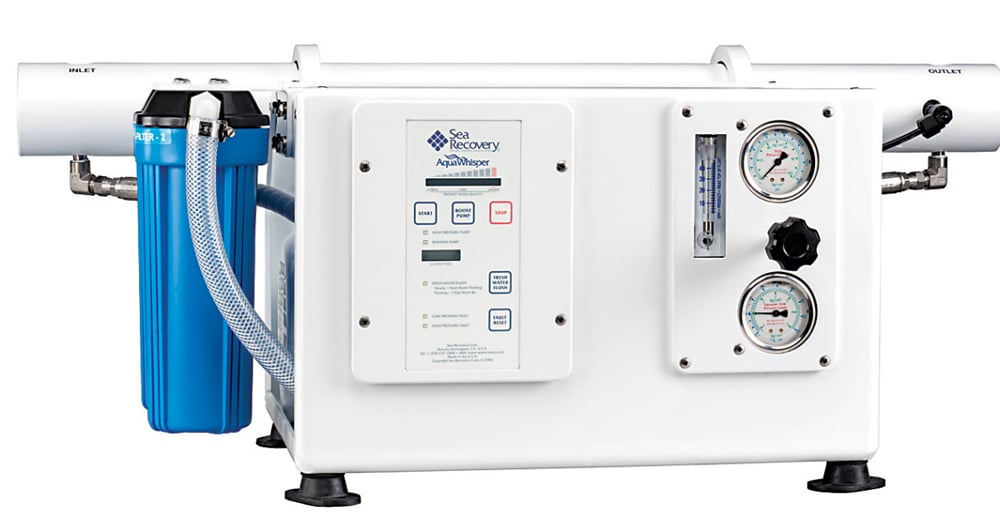
Freshwater Systems
As far as I know, neither Ben Franklin nor Rowland Howard were yachtsmen, but Howard spoke to a yachting issue when he paraphrased Franklin to observe that “you never miss the water till the well runs dry.” We, of course, have a water tank or two aboard rather than a well, but the point’s the same. We take a good, continuous supply of fresh water for granted aboard modern cruising yachts, and we sometimes don’t think much about the freshwater systems until we are forced to choose between taking a shower or cooking the pasta.
Freshwater systems are relatively straightforward and not too difficult to maintain if you understand a few basics. On small boats , a system can be as simple as a tank and a pump that comes on when a faucet is opened. Systems on most yachts, though, are a little more involved. They consist of one or more tanks, often with level monitors, feeding through a sediment filter to a pressure pump. The pump charges an accumulator (bladder) tank to maintain pressure without continuously running the pump. The pipe or hose from the accumulator then feeds to a manifold to supply cold water directly to the toilets, showers, tubs, lavatories, galley sinks and ice makers. It also feeds to a water heater, fitted with a temperature/ pressure relief valve for safety, to supply hot water to the showers, tubs and sinks. On larger yachts, there may be a connection to the washdown hoses and even to the firefighting system to avoid the damage that would result from spraying salt water inside the yacht in the event of a small fire.
The freshwater systems on yachts are potable; that is, both the water and the system’s components with which it comes into contact must meet the standards for drinking-water quality. In the United States, these are set by the Food and Drug Administration (FDA), so look for tanks, hoses and fittings made with FDA-approved materials, and always use such components when maintaining or repairing the system. This includes the tanks and components downstream, the tank fill and the vent lines, and make sure the vent lines terminate high enough to prevent them from submerging when the yacht rolls or takes a wave. If you’re careful about the water coming into the tank, the system should stay fairly clean, but ultraviolet sterilizers are available if you want to make sure you and your guests are as protected as possible.
Now, I have a bone to pick with current yacht design and construction practices. In my early years as a yacht designer, we put lots of freshwater tank capacity aboard, because only the largest yachts of the day could afford the space, expense and power needed for a steam distillation unit to produce fresh water under way. Then came reverse osmosis (RO) systems, also commonly known as watermakers, and eventually even the smallest yacht could afford one of the compact units to replenish the tanks. As a result, some new yachts have much smaller water tanks than their predecessors had. That, I think, is a mistake, and it came to light for me during an extended cruise on which we did a lot of gunkholing and anchoring. Because the tanks were too small to carry a sufficient supply, we had to run the generator to power the watermaker during periods in pristine anchorages where peace and quiet would have been preferable to the intrusive hum of the generator.
I’d opt for several tanks in ideal freshwater systems, filling only one for day trips, but filling them all for longer cruises, combined with a water maker large enough to recharge the tanks when running only a few hours a day. It’s more expensive but makes for a better cruising plan. Don’t suffer the fate of Samuel Taylor Coleridge’s ancient mariner — “Water, water, everywhere, nor any drop to drink.” Start with a good freshwater system and then maintain it to sustain your lifestyle.
Subscribe to the Yachting Life newsletter for cruising and chartering guides, new boat announcements, event updates, special offers and more!
- More: Cruising & Chartering
- More Cruising and Chartering
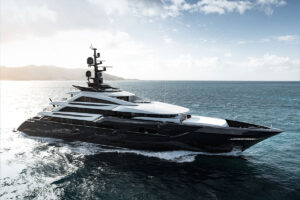
Charter Clients, Start Your Engines
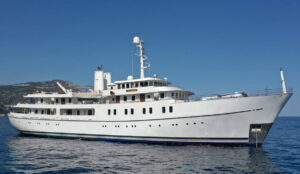
Exotic Yacht Charter Opportunities
Cruising to Key Largo
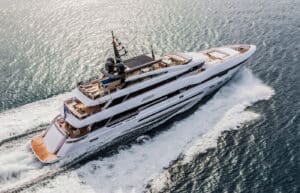
It’s Incentive Season for Charter Yachts
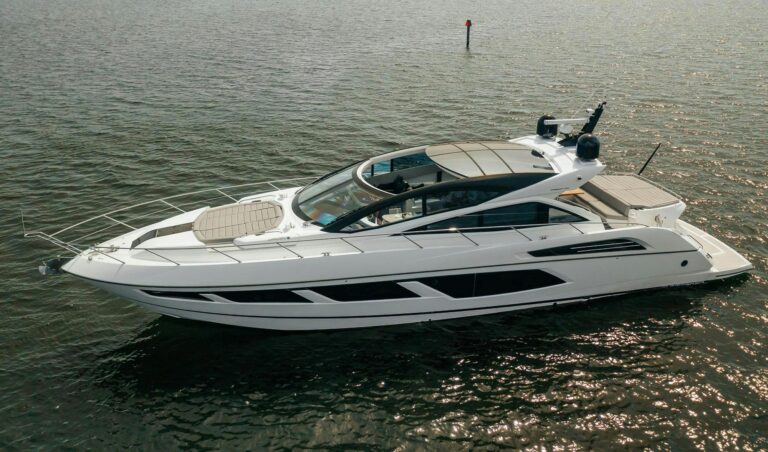
For Sale: Sunseeker Predator 68
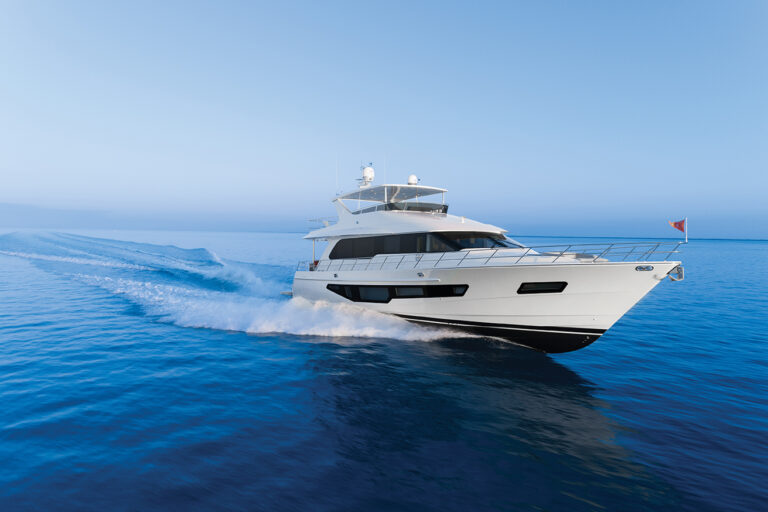
For Sale: CL Yachts CLB 72
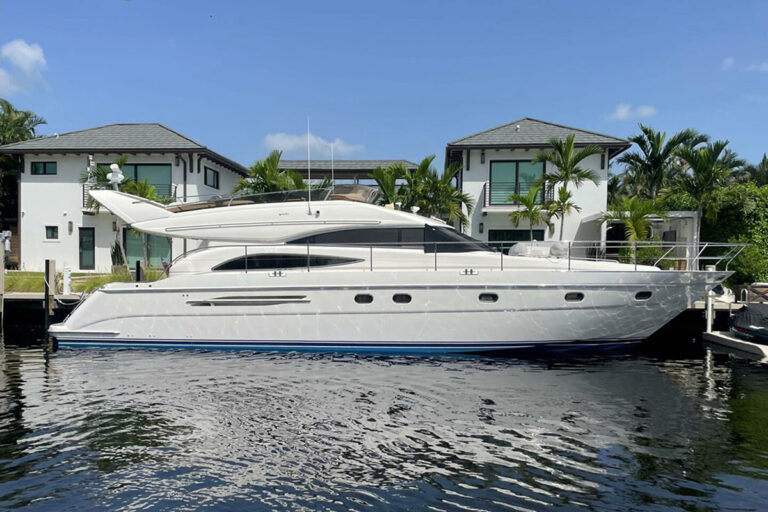
10 Yachts Under $500,000 You Can Have Today
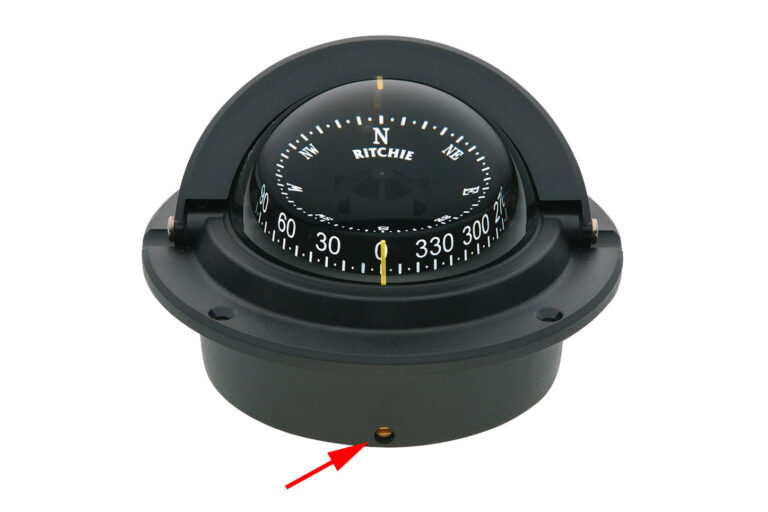
How to Swing a Compass on a Boat

- Digital Edition
- Customer Service
- Privacy Policy
- Email Newsletters
- Cruising World
- Sailing World
- Salt Water Sportsman
- Sport Fishing
- Wakeboarding
An introduction to watermakers for yachts

With thanks to VDM - Reya , Astilleros de Mallorca and Sea Recovery
While water management systems are vital to the smooth and cost-effective running of superyachts, they must operate seamlessly, effectively and without hassle. With a huge demand for fresh water for showers, baths, food preparation, laundry, washing down, etc. superyachts need to be able to produce their own fresh water through desalination.
Find suppliers of yacht watermakers in your area here

Having a yacht watermaker (also known as reverse osmosis desalination systems) on board is a huge advantage because of the reduced need to have large, heavy water tanks on board for long charters. Depending on the design, superyacht watermakers can be powered by electricity from the battery bank, an engine, or an AC generator.
The importance of a yacht watermaker
Astilleros de Mallorca commented, "First and foremost safety should be a paramount concern. When you consider the average superyacht passenger can consume anywhere from 30 gallons of water to 100 gallons of water per day, having a fully functional and quality watermaker on board, greatly limits the potential risk to crew and passengers by providing virtually limitless fresh water. This becomes even more essential in the event of an emergency that keeps a superyacht offshore for an extended period of time. This provides both crew and passengers with peace of mind."
Having the ability to make fresh water while you are underway frees the superyacht from the burden of carrying the water weight necessary to accommodate an entire voyage. Consider this, water weighs approximately 10 pounds per UK gallon (8.3 per US gallon) this extra weight adds up and can reduce the distance you can travel over a given period of time. It is also worth considering that if the superyacht is power driven, fuel costs will increase according to the additional weight carried on the journey.
How much water do you need?
There are plenty of watermakers on the market, but what sort of capacity is best for you? Experts say around 25 to 50 gallons of water per person per day is enough, you’re not going to drink that much water, certainly, or use nearly that much for showers and cooking, but an awful lot of water is used to wash down boats.
Of course, whatever the watermaker is used for, you’ve still got to figure out how often, and how long, you want to operate it. If you use, 30 gallons per day and you want to desalinate for three hours every day, you’ll need a 10 gallon-per-hour watermaker, or 240 gallons per day, to keep the tanks topped up. But a 400-gallons-per-day model, making 16 gallons per hour, will let you desalinate every other day for just less than four hours. It’s a balancing act.
Yacht watermaker misconceptions
When considering a watermaker for a smaller vessel, a complete picture is needed. There are some common myths which need to be dispelled before a fair decision on purchasing one can be made.
Myth 1: Watermakers are an expensive piece of equipment
It's true that a yacht watermaker may not be an essential piece of kit on a smaller vessel, but it is still an investment that must be thought about. (A very basic water model today costs somewhere upwards of £1500 for a yacht up to 20m and yachts over 30m start at around £14,000)
The cost of a watermaker is just as relative as GPS, radar, fenders, interior design, etc…, and just like this other equipment it offers convenience, flexibility and peace of mind.

Myth 2: Maintaining a watermaker is difficult and costly
A watermaker needs little maintenance and is much less of a drain on time and money then first considered.
watermaker membranes are probably the most expensive part to purchase, but just like everything else if looked after from the beginning and routinely flushed and then pickled, so the need to replace the membrane will become less frequent. Prevention is the key with watermakers, if you maintain them properly, they require little investment.
See a guide on watermaker maintenance here
Myth 3: Pickling a watermaker is complicated
Pickling is the process of preparing a watermaker for storage if it will not be used for a period of time. There seems to be an overwhelming misconception in the boating industry that this is a complicated process.
Firstly, it is not. Simply put, pickling is storing a watermaker. The only difference is that flushing the system with a solution is needed to prevent the growth of bacteria. That's it.
When the watermaker is needed again, just discard the product water for the first 15 - 20 minutes to be sure the solution has been completely rinsed from the system.
Myth 4: A lot of power is needed
As mentioned previously powering a watermaker can be done using a variety of methods (electricity from the battery bank, an engine, or an AC generator.) Most watermakers are engine-driven, in which case battery power isn’t getting used. If a motor boat is owned, the engine will be used all the time. If a sailboat is owned, the engine will be used regularly to accommodate for no wind. If the engine is going to be run anyway, why not use the energy to fill water tanks?
Battery-powered watermakers do consume a lot of power and sacrifices may have to be made when deciding on what to use fresh water for. However, Fabienne Guerin from Reya SAS , experts in electricity production and conversion commented, "Batteries have developed over the years allowing new opportunities for superyachts, commercial boats and offshore vessels.
Having exposed these myths around yacht watermakers, hopefully a fully informed decision can be made on whether or not one would suit your boat or superyacht.

Tried & Tested

A jacket completes any crew member's uniform so it's an important garment to get right. In this Tried & Tested, Sea Design pits eight popular jackets against one another to determine which one is best for superyacht crew in 2023.
iAQUA creates high-performance, technologically advanced underwater scooters. In this Tried & Tested, a team of experienced testers have rated and reviewed the AquaDart Pro and AquaDart Nano series to reveal the stand-out iAQUA sea scooter.
In our 2022 Tried & Tested, yacht toy specialist EAMS and a group of captains and crew review a selection of the very best luxury water toys on the market. Find out which toy was crowned the winner...
SeaYou will be returning to Marina Genova for its 4th edition on Thursday 18th April and Friday 19th April, 2024....

MB92 Group and Pinmar, part of GYG Ltd, has partnered to launch a sustainability initiative in collaboration with the Ba...

Popular Articles
Finished reading now find your perfect supplier..
Search our industry-leading directory for over 20,000 superyacht suppliers, providers and marinas.
- Motorcycles
- Car of the Month
- Destinations
- Men’s Fashion
- Watch Collector
- Art & Collectibles
- Vacation Homes
- Celebrity Homes
- New Construction
- Home Design
- Electronics
- Fine Dining
- Baja Bay Club
- Costa Palmas
- Fairmont Doha
- Four Seasons Private Residences Dominican Republic at Tropicalia
- Reynolds Lake Oconee
- Scott Dunn Travel
- Wilson Audio
- 672 Wine Club
- Sports & Leisure
- Health & Wellness
- Best of the Best
- The Ultimate Gift Guide
Meet the New Class of Freshwater Superyachts Bringing Bold Design to the Lakes
The vessels resemble their oceangoing cousins, but with expanded design possibilities., michael verdon, michael verdon's most recent stories.
- How a Little-Known Dublin Book Fest Transformed Into an A-Lister Summer Favorite
- The World’s Most Expensive Meal Will Cost You $495,000—and It Will Be Served in a Space Balloon
- This Sleek New Zero-Emissions Jet Will Fly on Liquid Hydrogen
- Share This Article

The term “freshwater yacht” was an oxymoron until J. David Weiss designed Invictus , a futuristic 80-footer that redefines large houseboats. Having penned dozens of oceangoing superyachts for Europe’s leading builders, Weiss was given carte blanche by Arizona-based Bravada Yachts to create a new freshwater category. “The designs have typically been boxy, bloated RVs,” he says. “The good news is their scale can provide a custom yacht experience.”
Related Stories
- This New Camper Shell Lets You Sleep on the Roof of Your Rivian
- 25 Fascinating Facts You Didn’t Know About Bugatti
- This Custom 112-Foot Trideck Superyacht Feels Bigger Than It Actually Is
The nearly $2 million Invictus has 3,200 square feet of space across two decks. The sprawling interior, with nine-foot ceilings, includes five staterooms, two full kitchens, customized daybeds and, true to its lake-boat DNA, a 15-foot water slide, while omnipresent glass delivers exceptional water views. Since even big lakes experience minimal wave action—at least compared to ocean swells—Weiss was able to push certain aspects of the design. “Bringing glass so low to the waterline is unheard of on a superyacht ,” he says. “Those kinds of differences let us explore what was possible” within the new category.

The 80-foot Invictus promises to be the first of a new generation of freshwater superyachts. Bravada Yachts
Companies in Australia and Germany are also launching new glass-centric freshwater designs. Status’s 60-foot, tri-deck Mischief , while boxier and less maneuverable than Invictus , has a sprawling, upscale interior, while a 90-foot, single-deck model from Berlin-based HouseBoatYacht resembles a floating glass studio.

The 60-foot, tri-deck Mischief . Status
Weiss expects a rapid evolution in the segment, with ever-larger and more elaborate designs. “It’s a great opportunity to move beyond the best-in-class designation and instead design a whole new class,” he says. “We’re really trying to do justice to what these vessels should look like in the 21st century.”
Bravada is entertaining a proposal for a 120-footer complete with helipad. “We’re also designing one for a music label with a recording studio on board,” he says. “The owner wanted unusual features and colors, and we’ll be delivering that.”
Read More On:
More marine.

This New 150-Foot Superyacht Can Cruise Through Shallow Waters in Florida and the Bahamas With Ease

Open Space, Eco-Friendly Tech: What a Rising Class of Millennial Superyacht Owners Is Looking For

‘People Don’t Want to Be Inside’: How the Outdoors Became Yachtmakers’ Most Coveted Design Element

This New 220-Foot Custom Superyacht Is Topped With an Epic Jacuzzi

Culinary Masters 2024
MAY 17 - 19 Join us for extraordinary meals from the nation’s brightest culinary minds.
Give the Gift of Luxury
Latest Galleries in Marine

Palm Beach Vitruvius in Photos

The 10 Most-Exciting Yacht Debuts at the Palm Beach International Boat Show
More from our brands, ln-cc london store overhauled with focus on elevated shopping experience, first four team or normal 16-seed nec commish prefers the former, ‘shayda,’ ‘the royal hotel’ share film honors at australia’s spa awards, sotheby’s will sell francis bacon portrait of george dyer with high estimate of $50 m., this folding treadmill is 20% off for amazon’s big spring sale.
Yachting World
- Digital Edition

Water on board: what should you carry? We ask ARC skippers for tips for an Atlantic crossing
- Toby Hodges
- August 17, 2015
Storing, rationing and making fresh water on board is a key concern when you're making an Atlantic crossing. Toby Hodges asks 193 skippers on the ARC for their tips

Photo: Richard Langdon/Ocean Images
So how do you decide how much water to ship for an ocean crossing?
Our survey of the Atlantic Rally for Cruisers (ARC) 2014 fleet centred around water, its stowage and use, and its production via watermakers. We asked all the skippers taking part in the ARC and ARC+ (via the Cape Verde Islands) detailed questions about how much water they carried, in what form, how they used it and their tips for water management. We also asked those with watermakers – almost 60 per cent of the fleet – how their equipment was powered and how it performed.
The overriding advice from the 193 respondents to our survey is to fit a watermaker. Although most skippers today are still very disciplined in their water rationing, the advent of reliable watermakers makes life aboard much more comfortable – and hygienic.
You can’t be complacent, however. A watermaker needs to be installed well in advance of an ocean crossing and maintained routinely. Even then they are not foolproof.

Yachts with watermakers on the 2014 ARC exceeded those without by some margin – 134 versus 88. The majority of those without watermakers were yachts in the 40-45ft bracket, which generally had 300-500lt tanks and more than 200lt of bottled water aboard.
The average LOA of yachts that carried a watermaker was 48ft (14.68m), but the range was great – the second smallest yacht in the fleet, the Allegro 33 Efwa , had a watermaker plus 150-200lt of bottled water to supplement their sub-300lt tanks. And the majority of those with watermakers still took 200lt plus of bottled water (the maximum amount they could indicate in our survey).
As well as for drinking, showering and cooking, water was used mostly for washing dishes, decks and clothes, and general cleaning. “Diluting whisky,” was a necessary requirement reported by Oyster 575 Helen .
But the Lagoon 450 Ripples would get my vote for the yacht to be aboard, as water was needed for the “washing machine, ice-maker and foot spa”.
Bottled water
The 193 yachts surveyed on the 2014 Atlantic crossing between them carried more than 27,720lt of bottled water, or an average of 144lt per boat. And as the maximum amount they could enter was ‘200lt plus’, in reality the average was probably a fair bit higher.

What really strikes us here is the amount of plastic carried across the Atlantic. Yet there was only one comment on a viable alternative, from Nicola Henderson on the First 40.7 Hot Stuff : “Use collapsible water containers (available from eBay) – no rubbish and can be reused.” It is likely that many crews shipped water in large jerrycans too.
Managing water – the skippers’ tips
Use salt water.
Other than installing a watermaker, the biggest piece of advice from the ARC skippers is to use salt water wherever possible. Whether washing dishes, clothes, taking seawater showers (finished with a fresh water rinse) or boiling carbs, the use of the abundant resource you are sailing on makes good sense. After all, the world’s best shower is a mid-Atlantic swim – or a bucket over the head on the aft deck.
The top tip from many skippers was to install a saltwater pump in the galley and heads. “Seawater can be used in all sinks on board,” declared the crew of XC42 Euphoria . “Shut down the pumps and only use seawater for washing hands. Shower from buckets on the aft deck.”

Florent Duperron says they used salt water for dishes, laundry and showering (from buckets) aboard the Hallberg-Rassy 352 Millicent . For freshwater rinses, water was measured out in one-litre bottles to keep a tab on how much was used.
By using predominantly sea water, the ten crewmembers aboard the 59ft Peter von Seestermuhe used just 500lt of fresh water over 15 days.
Be disciplined with rationing
“Do not give the crew unlimited access to the bottled water,” was the advice from Hanse 445 Fortune Cookie skipper Wilhelm Bögershausen. Ayama ’s Stefan Berg was also adamant: “Don’t use bottled water; use tank and watermaker; carry 20lt bottled for emergency.”
Scarlet Oyster ’s skipper Ross Applebey concurred, recommending his method of “emergency water bottled in the bilge and using a day tank filled by the watermaker”. His top tips were also to “turn off the electric pump and wash dishes in salt water”.
The crew of Swan 80 Berenice admitted they should have carried more water (this despite having 1,000lt+ tanks, 200lt+ bottled and a watermaker) to cater for 12 on board. Interestingly, they had no saltwater or manual pump.
Limit running water
- “When you open the tap, immediately half close it,” Jeanneau SO49DS Soulmate recommended.
- “Wash dishes in salt water and turn off water pressure switch on panel,” Hunter 410, Morning Haze .
- “Turn the pump pressure down so all taps run slower,” Humphreys 77 Aglaia .
- “Keep water pressure pump off at all times,” said Swan 46 Aphrodite .
- “Switch off electric pumps and dispense water to crew in bottles so you know the intake,” Jeanneau Trinidad 48 Aislig Bheag .
- “Transfer out of tanks to bottles for a daily amount for cooking and 1-1.5/2lt bottle in heads for usage, in case the gauges are not accurate,” First 40 Southern Child .
- “Fit an adaptor to the mixer tap that allows you to stop the flow without wasting water temp,” Hallberg-Rassy 39 Anika .
- “Collect cold water from the shower when waiting for hot,” Outremer 51 Intrepid Elk .
Keep some in reserve
Both the 100ft Leopard by Finla nd and the Jeanneau SO54DS Theta recommended keeping one tank full and isolated for emergency use only.
Meanwhile, crew on Swan 65 King’s Legend said they “only drink watermaker water. Bottles are for emergency.”
“Keep one tank full and untouched. Send made water to the other. When watermaker fails the other tank is full in reserve,” declared the crew of Reservoir Dogs.

“Refill empty plastic bottles with watermaker water,” said Paul Frew on Oyster 575 Juno . This advice was echoed by Oyster 46 Cloud 9 of Kingswear , which “arrived with same amount of drinking water that we left Canaries with”.
“We carefully regulate bottles available in one locker so we can easily see what is being used,” First 40.7 Lancelot II .
Be creative with your drinking water
- “We use exclusively water coming from the watermaker. For cooking and drinking, water from the watertank is filtered through a Seagull filter. We fill our bottles from this and carbonate them with a Sodastream system to have perfect sparkling fresh drinking water,” Amel 54 A Plus 2 .
- “Add minerals to tap water,” Sly 47 Neveralon .
- “Alternate tanks to be used to ensure fresh water,” Leopard 44 Libeccio .
- “Collect rainwater from the hardtop,” [catamaran] Privilege 37 Tanoa .
- 1. The stats
- 2. How a watermaker works
- 3. Watermakers – skippers’ views
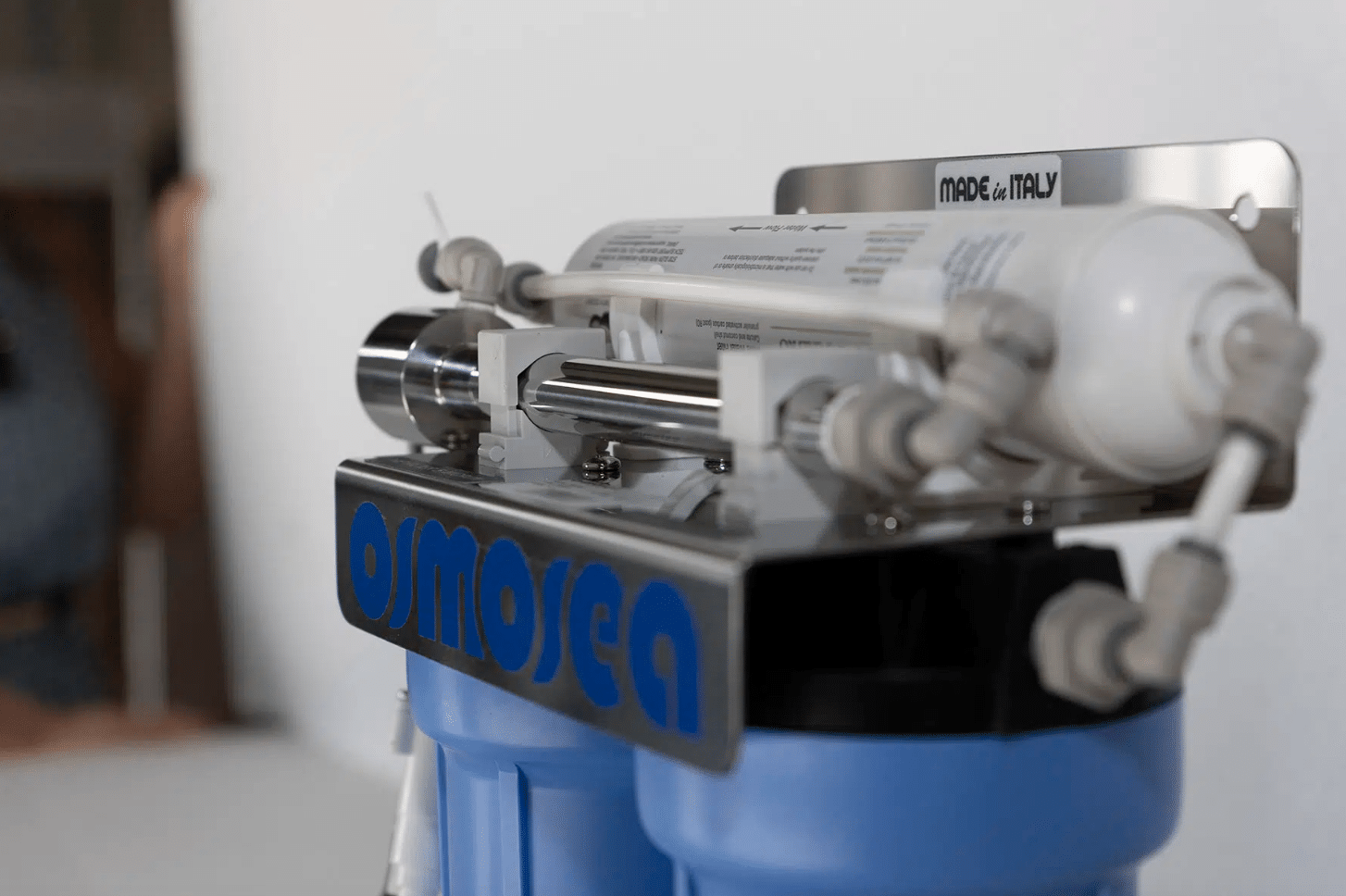
Osmosea watermakers: the privilege of getting fresh water aboard at all times

Osmosea watermakers: the freedom of having fresh water on board at all times
One of the things that you need to keep most under control when on board is unquestionably the amount of fresh water available. Osmosea knows this well. The Sicilian watermaker and water treatment plant company, in fact, successfully promotes installations all over the world to make you independent from the water supply in port, and more.
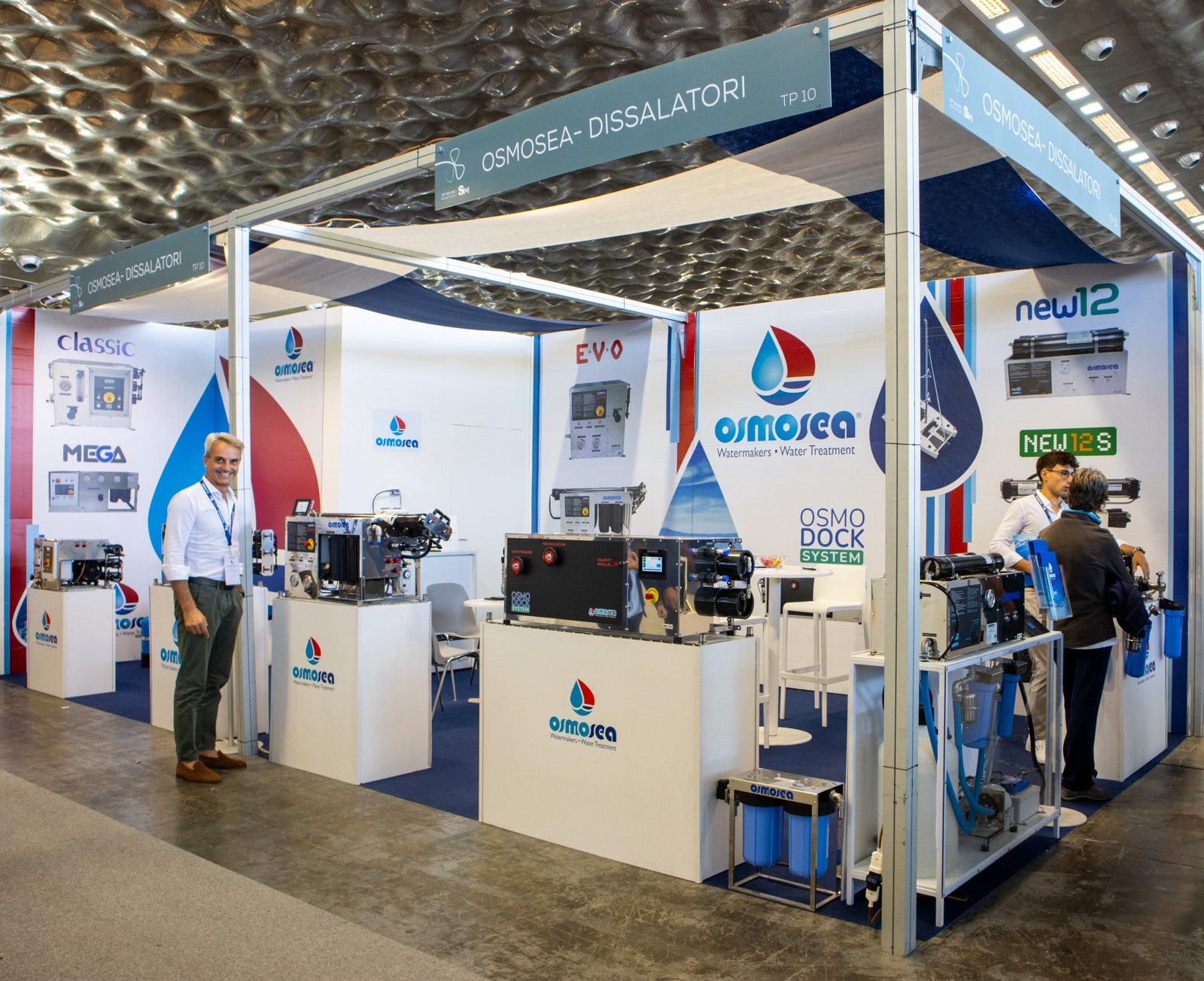
With NEW 12 and NEW 12S , the energy-saving watermakers save about 80% of power and are suitable for small to medium-sized boats. The range also includes the Classic and Evo models, watermakers powered by a generator, with flow rates of up to 3,000 l/h.
It is also possible to install the DUO , i.e., a system composed of 2 watermakers (which occupies little more space than a single watermaker) and allows to choose a different type of power supply (12/24V or 230V), and provides the security of having a backup system even in case of failure, and finally, also allowing to adjust a different amount of production between the two watermakers, adapting it to various needs.

The Sicilian company’s products are already highly appreciated (and installed) around the globe, which is why Osmosea is aiming to participate in the most important international boat shows, making its first debut at the Fort Lauderdale International Boat Show, and then attending METS next November, as well as Boot in Düsseldorf in January 2024, starting the show season again in the spring of 2024.

Osmosea srl
C.da Amabilina 756 Z.A 91025 Marsala (TP)
Tel. +39 0923 719867 E-mail: [email protected]
You might be interested in.

Dubai yachting conference addresses key issues
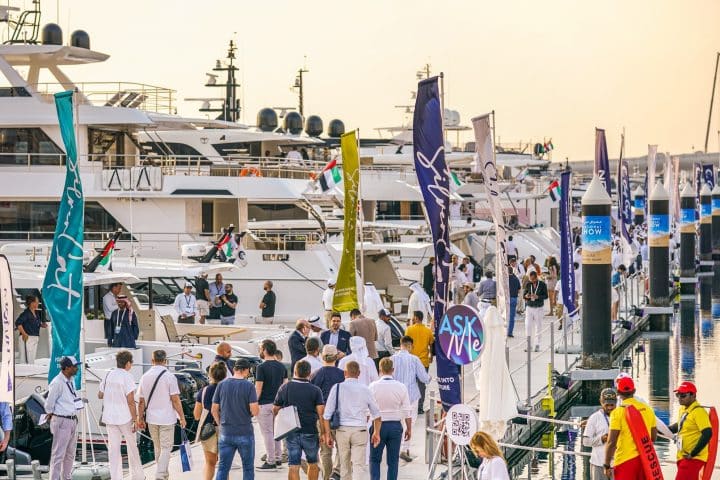
Dubai International Boat Show, 30th edition kicks off
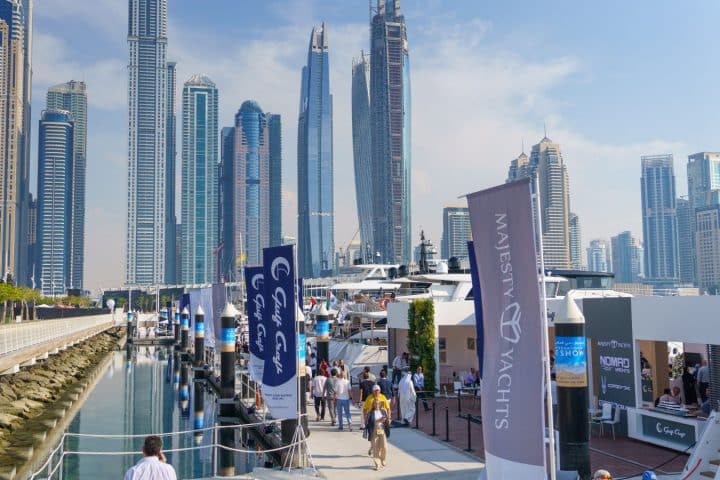
Dubai International Boat Show and The International Yachting Media: media partnership agreement signed for second year
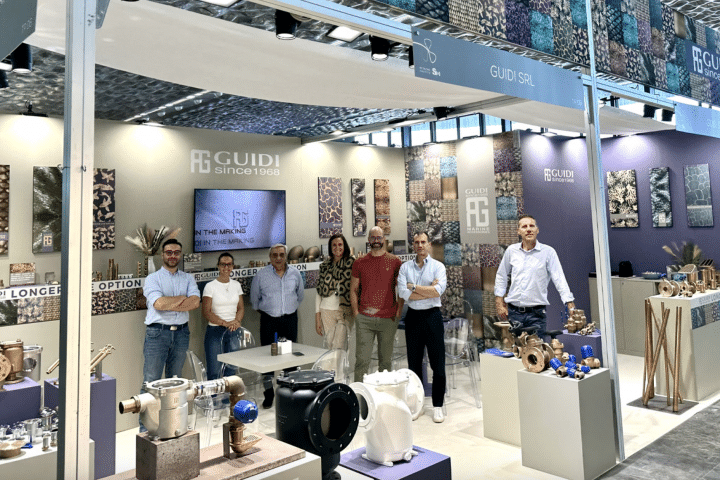
Guidi Srl: special focus on materials in marine accessories
Subscribe for latest updates.
Sign up to receive the best of superyachts news, world premieres and shipyards new models.
The only ADVERTISING FREE newsletter
Yacht Dreaming
Where Do Yachts Get Their Fresh Water From?

With the abundance of luxury yachts in the market, it can be difficult to decide which one is the best for you. But don’t worry, we’ve got you covered. We’ve done the research and compiled a list of the top 5 luxury yachts in the world – Feadship, Lurssen, Oceanco, Benetti, and Christensen – that offer the ultimate in comfort, style, and performance. Sit back, relax, and let us help you find the perfect luxury yacht for your next sail.
The Best Luxury Yachts
If you’re looking for the perfect yacht, you won’t find a better selection than the best luxury yachts in the world. From Feadship to Lurssen, Oceanco, Benetti and Christensen, you can’t go wrong.
These top-notch companies provide top-of-the-line features, performance and style, allowing you to make a statement on the water. Whether you’re looking for speed and power or luxurious accommodations, you’ll be sure to find the yacht of your dreams with one of these companies.
You won’t have to worry about settling for a sub-par yacht either. The best luxury yachts are equipped with top-tier amenities, from advanced navigation systems to a fully-stocked galley and even onboard spas. Whether you’re looking for an intimate getaway or a gathering place for friends and family, these yachts are sure to exceed your expectations.
With the highest quality materials and craftsmanship, you can rest assured knowing you’re in good hands. If you’re looking for an unforgettable experience, look no further than the best luxury yachts in the world.
Feadship is arguably one of the best luxury yachts in the world. Known for its superior craftsmanship, Feadships are the perfect combination of power, stability, speed, and comfort. With sleek lines, timeless style, and top-notch amenities, these luxury yachts can provide guests with one of the most luxurious yachting experiences available.
Whether you’re looking to cruise around the Mediterranean or explore the Caribbean, Feadship is sure to deliver. And with the latest technology and a wide range of choices, you can customize your yacht to fit your exact needs. So if you’re looking for a luxurious and luxurious yacht, Feadship is your go-to option.
Lurssen is a great option if you are looking for a top-of-the-line luxury yacht. The German-based shipyard produces some of the best yachts in the world, with sleek designs, beautiful interiors and state-of-the-art features. They have over 130 years of experience in the industry, and their award-winning designs have been featured in numerous magazines and publications.
Their vessels come with the highest safety standards, meaning you can sail with confidence.
If you are after an opulent and stylish yacht that is unmatched in terms of performance and quality, then Lurssen should be your go-to. Luxury comes as standard with a Lurssen yacht, and they have a wide range of options available to suit your needs. From sleek motor yachts and sailing yachts to classic superyachts and expedition vessels, you are sure to find something that is perfect for your needs.
The company offers custom-built vessels, so you can create a yacht that is truly unique and personalized. In conclusion, Lurssen is a great choice if you are looking for a luxury yacht that combines elegance, performance and quality.
With decades of experience and award-winning designs, you can be sure that you will be getting a vessel that is second to none. Whether you are after a sleek motor yacht or a classic superyacht, you can be sure that Lurssen will provide a vessel that you can be proud of.
If you’re looking for a truly luxurious yacht, then look no further than Oceanco. The company has been building some of the world’s most spectacular yachts since 1990, and their attention to detail and craftsmanship are unparalleled. From their sleek, modern designs to their expertly crafted interiors, Oceanco’s yachts are sure to impress.
Whether you’re looking for a yacht for a weekend cruise or something to serve as your primary residence, you’ll be spoilt for choice with an Oceanco.
You’ll also benefit from their extensive experience in the industry, with advanced navigation systems, state-of-the-art propulsion systems, and luxurious amenities to keep you entertained. The advanced engineering and construction methods mean you can count on your yacht to be reliable and safe. If you’re looking for a one-of-a-kind experience, then Oceanco is the way to go.
The custom designs mean you can choose the style and amenities that best fit your needs.
With an interior designer and an experienced crew to ensure your yacht is just as you envisioned, you can create a truly unique experience. From the stunning artwork and plush furnishings to the custom-built amenities and modern technology, you’ll be amazed by the possibilities.
And with a wide variety of sizes and designs, you’re sure to find something that matches your lifestyle. At the end of the day, Oceanco offers some of the best luxury yachts in the world. You can trust that you’re getting quality, style, and performance with every yacht they make.
With their vast experience and expertise in the industry, you can be sure that you’re getting a boat that will last for years to come. So if you’re looking for the best of the best in luxury yachts, then look no further than Oceanco.
If you’re looking for a luxurious and iconic yacht, then Benetti should be at the top of your list. Benetti yachts are renowned for their classic, timeless design and superior quality craftsmanship. The interiors are spacious and inviting, with exquisite finishes and fittings that make them a true delight to cruise aboard.
They feature stylish and comfortable cabins, as well as a wide range of state-of-the-art amenities that allow you to travel in luxury and style. Benetti yachts are also renowned for their performance on the open sea, ensuring smooth sailing and an enjoyable experience. With the added bonus of a highly skilled and experienced crew , Benetti creates an exceptional experience for all who sail aboard them.
Christensen
Christensen is the perfect yacht for those who truly value luxury and high performance. Its sleek design allows for impressive maneuverability and speed without sacrificing comfort.
With its state-of-the-art custom interiors and modern amenities, Christensen is the ultimate in luxury yachting. From its luxurious bedrooms and stunning dining areas to its expansive decks and lounges, Christensen offers exquisite style and sophistication.
With its world-class navigation and communications systems, Christensen allows you to explore the world in total comfort and security. Whether you’re looking for a romantic getaway or an adventure-filled voyage, Christensen is the ideal choice for a luxury yacht experience.
Christensen yachts are renowned for their cutting-edge technology and engineering. The company’s proprietary engineering process allows for precise customizations, ensuring that each yacht is a perfect blend of performance and luxury.
Christensen yachts feature a variety of advanced features, such as automated navigation systems and advanced entertainment systems. Their advanced engineering also ensures that they are able to handle any weather conditions, giving you the freedom to explore wherever you desire.
Whether you’re looking for a classic sailing experience or a luxurious cruise, Christensen offers the best in luxury yachting. With its cutting-edge technology, unrivaled comfort, and exquisite style, Christensen is the perfect choice for the discerning yachting enthusiast. From its luxurious amenities to its unparalleled performance, Christensen is the ideal choice for an unforgettable luxury yacht experience.
When it comes to luxury yachts, there are a few brands that stand out from the rest. Lurssen, Oceanco, Benetti, and Christensen all offer the pinnacle of comfort, style, and performance. While the decision of which luxury yacht is best depends on your own preferences, these are the brands you should keep in mind when searching for the ultimate in luxury boats.
If you’re looking for a top-of-the-line yacht, you can’t go wrong with one of these five brands.
Each offers its own unique combination of performance and luxury, so it’s important to do your research and find the one that best suits your needs. Whether you’re looking for a large yacht for entertaining or a smaller one for cruising, you can trust these brands to provide you with the best experience possible. Go ahead and start your search for the perfect luxury yacht today!
What Are the Benefits of Owning a Yacht in BC?
Why Does a Boat Float: Uncovering the Science Behind Yachting
© 2024 Yacht Dreaming


By SuperyachtNews in collaboration with EPE YACHTING 17 Aug 2023
SPONSORED CONTENT
Sustainable superyachts dispense with bottled water
With safe drinking water vital for any vessel at sea, epe yachting showcases its range of freshwater-treatment systems….
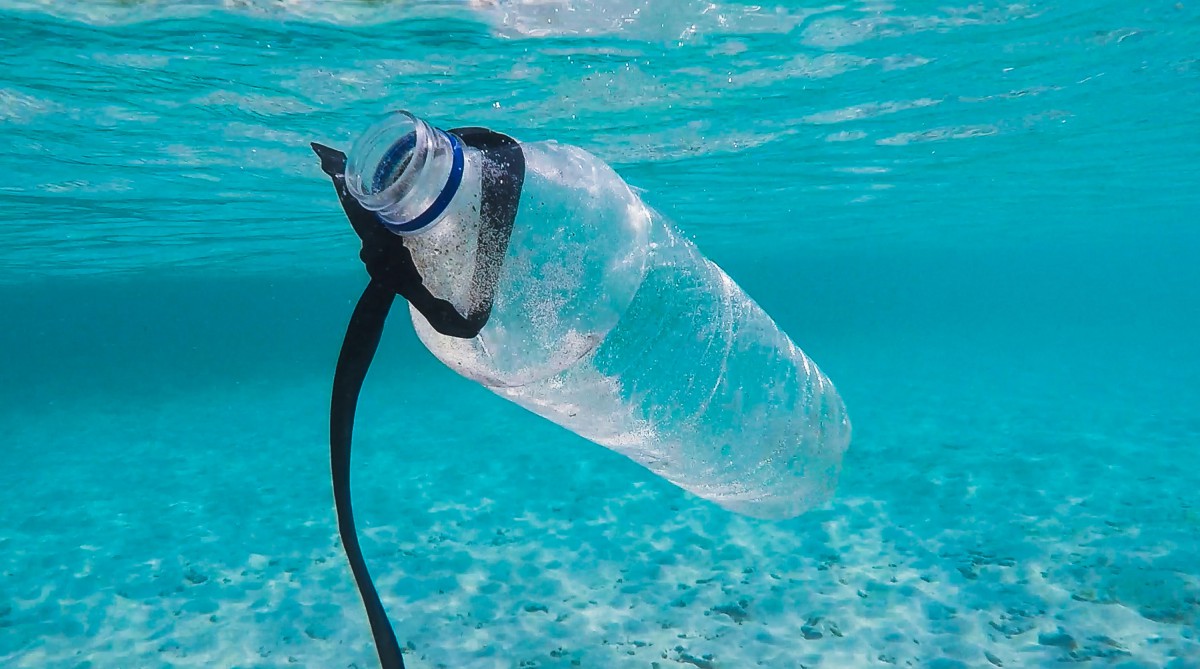
As the most important resource for human survival, safe drinking water is vital for any vessel at sea. But water also presents a storage challenge, while trust in quality can be fragile if water ‘on tap’ is really from a tank.
All vessels need water-treatment systems on board to deal with functions such as ballast-water management, oil-water separation and waste management, but also to support sanitation, laundry, cooking and other needs. Fresh water, however, can be bunkered or produced from seawater by using a desalination plant on board – the latter saving storage space and cutting a vessel’s weight, fuel consumption and CO 2 emissions.
For obvious reasons, though, drinkable, or ‘potable’, water on ships is subject to scrutiny. It must come from sources that are approved by the relevant health authority, for example, with responsibility for ensuring safety for use falling to the ship’s master or the officer in charge of loading.
Beyond appearance, colour and taste, drinking water at sea should have been assessed for PH, conductivity, salinity, chlorine, metals and hardness, with samples also taken to verify the absence of microbial contamination. Best practice requires each ship operator to follow a water safety plan, which includes procedures for purchasing, delivery, sampling, storage and distribution of drinking water on board.
For those on board a yacht at sea, however, bottled water can often seem the safest option, despite the self-evident wasteful use of plastics. One reason can be that the water which apparently meets the searching requirements of best practice does not taste so good.
Sustainable drinking-water solutions EPE Yachting, a division of the leading marine environmental protection organisation Environmental Protection Engineering (EPE) S.A. , is on a mission to ensure that guests and crew members alike have no reason to insist on bottled water. Tasked with delivering sustainable solutions that fully engage with the needs of the yachting audience, the division has secured agreements to supply innovations in drinking water production which merit trust that will be proven in the tasting.
EPE Yachting offers a range of freshwater treatment systems to suit the requirements of individual yachts.
ALIOS, for example, is a reverse osmosis system that produces reliable fresh water from the desalination of sea water. The system has been designed to suit all sizes of modern superyachts, while still remaining compact, making it ideal for both retrofits and new builds. ALIOS is manufactured using high quality materials to ensure maximum efficiency throughout its life. It also features automated back flushing with fresh water which not only prolongs the life of the membranes, but ensures the fresh water produced is free of any unwanted substances.
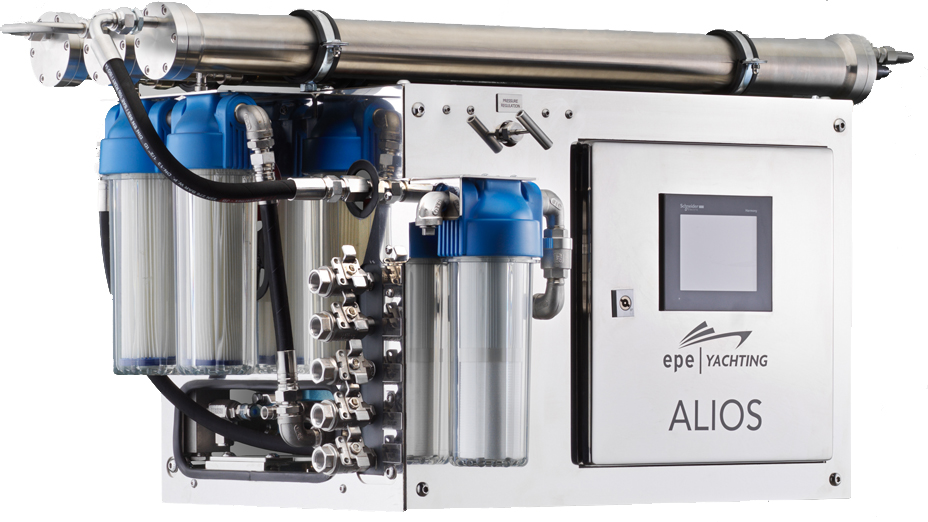
Some of its latest additions are the Slim Line and M70 Soda drinking water systems from Octo Marine, which are supplied by EPE Yachting on an exclusive distributor basis in Greece. The two systems allow yachts to be completely self sufficient by ensuring there is always high-quality, fresh mineral water available to drink on board.
Cool running-water system The M70 Soda system can also be installed alongside water filtration units, such as the Slim Line and ALIOS systems to provide unlimited ambient, chilled or sparkling water on tap, completely eradicating the need for bottled water.
With regulations tightening and guests also increasingly expecting sustainability measures to be proactive, a 360-degree approach to environmental protection is becoming essential. This needs to focus on technology and solutions that minimise environmental impact without compromising quality and guest experiences, while also fully understanding the financial and operational requirements of vessel owners themselves.
Profile links
Environmental Protection Engineering
Join the discussion
Supporting the transition to sustainable yachting practices.
To post comments please Sign in or Register
When commenting please follow our house rules
Click here to become part of The Superyacht Group community, and join us in our mission to make this industry accessible to all, and prosperous for the long-term. We are offering access to the superyacht industry’s most comprehensive and longstanding archive of business-critical information, as well as a comprehensive, real-time superyacht fleet database, for just £10 per month, because we are One Industry with One Mission. Sign up here .
Related news

“Let’s all get behind a new designers’ protocol”
Dickie Bannenberg calls for a standardised industry document that contains guiding sustainability principles for every yacht designer
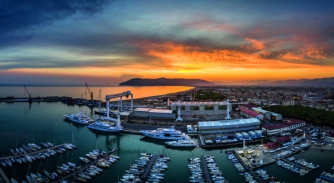
TISG outlines ESG commitments
The Italian Sea Group details its diverse ESG strategy to reduce current CO2 emissions as well as offset those from 2022

Turbulence ahead
As the landmark ‘greenwashing’ case against the Dutch air carrier proceeds to full trial, the superyacht industry should take note

Developing trust and value beyond a word
People often say “we have to think green”, not “we are thinking green"
8 months ago
9 months ago
2 years ago
Sign up to the SuperyachtNews Bulletin
Receive unrivalled market intelligence, weekly headlines and the most relevant and insightful journalism directly to your inbox.
Sign up to the SuperyachtNews Bulletin
The superyachtnews app.

Follow us on
Media Pack Request
Please select exactly what you would like to receive from us by ticking the boxes below:
SuperyachtNews.com
Register to comment


How Do Yachts Get Fresh Water?
Getting fresh water on a boat is crucial for maintaining hydration, cooking, personal hygiene, cleaning, equipment operation, emergency preparedness, and overall comfort. Fresh water is essential for drinking, preventing dehydration, and supporting bodily functions. It is needed for cooking meals, cleaning ingredients, and maintaining proper hygiene on board. Fresh water is also used for cleaning the boat, rinsing equipment, and ensuring systems operate effectively. In emergency situations, it serves as a vital resource for first aid and providing drinking water. Having an adequate supply of fresh water enhances comfort, cleanliness, and overall enjoyment while out at sea. So, how do yachts get fresh water? Our boat desalination unit manufacturer explores more in the following article.
How Do Yachts Have Fresh Water?
How do yachts get fresh water? Yachts typically have fresh water on board through a combination of storage tanks, watermakers, and shore connections. Freshwater storage tanks are built into the yacht’s structure and can hold a certain capacity of water. One of the ways that yachts get access to fresh water is by filling up water tanks when the boat is docked. This is an incredibly convenient process for boats to get fresh drinking water when they are connected to the shore. However, this is inconvenient when the boat is not docked. In this case, the best course of action would be to purchase a watermaker for the yacht system. This allows fresh water to be made from the water that the boat is floating on. This means that boaters have a virtually unlimited supply of water when they are using their boat. Some of the most popular fresh watermakers for boats include our selection of watermakers. These are:
- 12/24v DC Economy Watermakers
- 115/230v AC Yacht Series (Modular)
- Belt-Driven DC Watermakers (Modular)
- 115/230v AC Pro Series (Semi-Modular/Self-contained)
- 12 – 180v DC Watermakers
- And other 12v watermakers
How Do Fresh Watermakers for Boats Work?
Reverse osmosis (RO) is a process that uses pressure to force water through a semipermeable membrane, removing impurities and producing purified water. Water is pressurized and forced through the membrane, allowing only water molecules to pass while blocking contaminants and dissolved solids. This process effectively removes salts, minerals, bacteria, viruses, and other impurities from the water. The purified water, known as permeate, is collected, while the concentrated impurities are diverted as reject or brine.
What Are Fresh Water Pumps for Yachts?
Our engine-driven watermaker manufacturer would like to point out the difference between pumps and watermakers. Freshwater pumps for yachts are devices that are used to circulate and deliver fresh water throughout the yacht’s plumbing system. These pumps play a crucial role in providing a pressurized water supply for various onboard applications. While these pumps are crucial to a boat, they do not produce fresh water.
More About ECHOTec Watermakers
How do yachts get fresh water? We hope we were able to answer this question and more for you in our article. ECHOTec Watermakers is a team of manufacturers for fresh watermakers that are dedicated to making sure that our customers have the highest quality products available for the price. Our marine desalination systems are here to give you an effective and necessary tool for you to enjoy. Schedule an appointment with us today to learn more about our engine-driven watermakers and sailboat watermakers.
You May Also Like
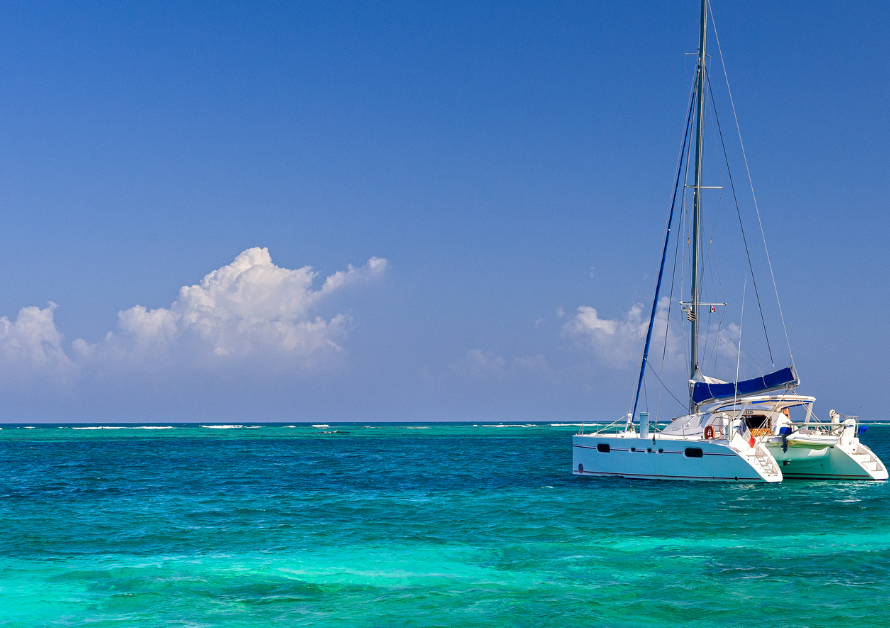
About Catamaran Watermakers
こだわり条件を追加 [ 選択した条件をクリア ]

{{list.caption}}
{{list.supplement}}
アメリヴィンテージ DOUBLE TAG SHIRT SET UP 新品シャツ/ブラウス(七分/長袖)

AMERI(アメリ)の「DOUBLE TAG SHIRT SET UP(シャツ/ブラウス)」 - WEAR
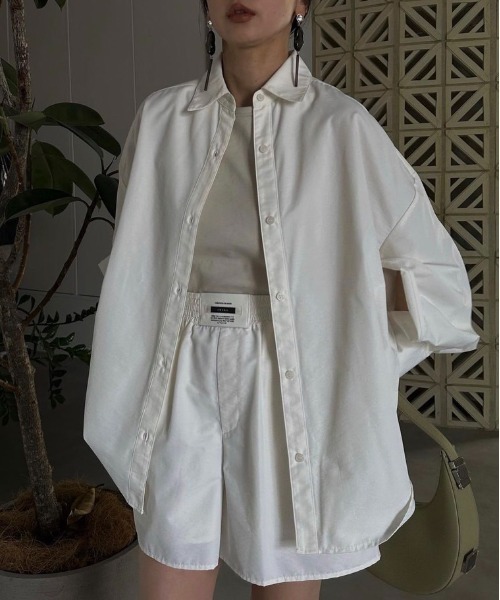
2024年最新】double tag shirt set upの人気アイテム - メルカリ

VINTAGE NUMBER (N)INE NINE DENIM JAPAN SPELL OUT JAPAN T SHIRT M NOT UNDERCOVER
5 (772件の商品レビュー)
送料無料 (全国一律)
※条件により送料が異なる場合があります。
ご注意 表示よりも実際の付与数・付与率が少ない場合があります(付与上限、未確定の付与等)
「PayPaySTEP」は、付与率の基準となる他のお取引についてキャンセル等をされたことで、付与条件が未達成となる場合があります。この場合、表示された付与数・付与率では付与されません。なお、詳細はPayPayステップの ヘルプページ でご確認ください。
ヤフー株式会社またはPayPay株式会社が、不正行為のおそれがあると判断した場合(複数のsoilsustain.ch! JAPAN IDによるお一人様によるご注文と判断した場合を含みますがこれに限られません)には、表示された付与数・付与率では付与されない場合があります。
各特典に設定された「付与上限」を考慮した数字を表示できないケースがございます。その場合、実際の付与数・付与率は表示よりも低くなります。各特典の付与上限は、各特典の詳細ページをご確認ください。
付与数は算定過程で切り捨て計算されている場合があります。付与数と付与率に齟齬がある場合、付与数の方が正確な数字になります。
原則税抜価格が対象です。特典詳細は内訳でご確認ください。
取寄せ品 ※欠品時ご連絡
※発送予定日はストアに お問い合わせ ください
すべてのお届け方法とお届け日を確認する
お届け方法とお届け情報
※お届け先が離島・一部山間部の場合、お届け希望日にお届けできない場合がございます。
※ご注文個数やお支払い方法によっては、お届け日が変わる場合がございますのでご注意ください。詳しくはご注文手続き画面にて選択可能なお届け希望日をご確認ください。
※ストア休業日が設定されてる場合、お届け日情報はストア休業日を考慮して表示しています。ストア休業日については、営業カレンダーをご確認ください。
情報を取得できませんでした
時間を置いてからやり直してください。
24時間以内に注文した方がいます
選択されていない項目があります。 選択肢を確認してから カートに入れるボタンを押してください。
- 手数料・送料・配送方法について(お買い物ガイド)
(772 件の商品レビュー)
- 星の数 すべての星の数 星1(0件) 星2(0件) 星3(0件) 星4(0件) 星5(772 件)
該当するレビューコメントはありません
お買い物レビュー閲覧の際の注意事項
- この商品のレビューをもっと見る
この商品に関するQ&A
- この商品について質問する
- シャツ/ブラウス(七分/長袖)
Z8042865612
レディース専門店です。
- このストアをお気に入り
- 販売条件、返品、交換について
一緒に見られている商品と比較
※免責事項(必ずご確認ください)
掲載情報は出店者ではなくヤフー株式会社が独自に作成・掲載する参考情報となります。内容の正確性は保証いたしかねますので、ご購入の際は、お客様においてメーカー公式サイト等で改めてご確認をお願いいたします。なお、掲載情報に誤りがある場合は、soilsustain.ch!ショッピングカスタマーサービスまでお問い合わせをお願いいたします。
現在 852人 がカートに入れています
閲覧しているストアの商品

!ショッピングからのお知らせ
掲載商品の情報について
掲載している情報の精度には万全を期しておりますが、その内容の正確性、安全性、有用性を保証するものではありません。 現在ご覧になっているページは、この商品を取り扱うストアによって運営されています。 ページに記載されている内容や商品、ご購入に関するご質問は、直接各ストアにお問い合わせください。
© yachtingnewsreport.com
- Articles and Guides
Superyachts 101: All Your Questions Answered
26th may 2022 by samantha wilson.

There is something fascinating about superyachts. Their size, glamour and innovation pique our curiosity and, for boat owners in particular, are the epitome of boating luxury. Whether you’re in the market to buy a superyacht, considering your first superyacht charter or simply a boat fan who wants to understand more about these famous yachts, then we’ve got all the top asked questions answered for you. This is superyacht trivia 101:
What Defines a Superyacht?
Superyachts are defined as motor yachts or sailing yachts over 24 metres in length. The size and variety within those parameters are enormous, as the yachts can range from 24 metres to 100 metres +. While superyachts are synonymous with on board swimming pools or hot tubs, helipads, large tenders, spacious decks and large crews, the true classification actually depends on length.
How Many Superyachts are there?
With the superyacht industry’s order book bulging and new superyachts hitting the water every month, it is hard to give an exact number, but there are around 10,000 yachts worldwide measuring 24 metres or more. With over 1,000 superyachts on order for 2022 alone, it is a clear picture of the boom the industry is currently undergoing. In fact, there is an estimated 40 kilometres of superyachts due to be built and launched by 2026.
What are the Biggest Superyachts?
The current longest superyacht in the world is Azzam at 180.61metres. She was built in 2013 by Lurssen shipyard and has held the title ever since. Some of the other yachts in the top 10 largest superyachts list include Eclipse at 162.5 metres built by Blohm and Voss for Paul Allen in 2010, Dubai at 162 metres, Blue at 160 metres, Dilbar at 156 metres, Al Said at 155 metres and A+ at 147.25 metres. Sailing Yacht A is the largest sailing yacht at 142.81 metres.
How much do Superyachts Cost?
It is no secret that superyachts are one of the most expensive luxury items in the world, and often far outprice even the largest of real estate properties. Joining the elite group of superyacht owners requires a healthy capital, not just for the initial purchase price but for the annual upkeep, which can easily run into the millions (read our article on the True Price of Owning a Superyacht). Having said that, superyachts come in all shapes and sizes and the price for a smaller superyacht (in the 24 metre category) will be far less than a larger vessel, as will an older yacht compared to a new build.
The average sale price for a superyacht is around €8 million, however a 24 metre yacht could be around €1 million (or less for used superyachts), €11 million in the 40m-50m category, €24 million in the 50m-70m category and around €80 million for yachts of 70m or more. Some of the largest yachts in the world (those over 100 metres in length) can go for up to as €175 million.
What are the Most Expensive Superyachts?
For the most part, the largest yachts in the world generally rank as the most expensive. The largest yacht ever built, the 180 metre long Azzam, cost over €550 million to build in 2013, while Roman Abramovich’s Eclipse is believed to have cost a staggering $1.5 billion. Another yacht on the billion dollar list is the new 155 metre Streets of Monaco. Designed to feature mini versions of Monaco’s landmarks it will also boast a go-kart circuit, three swimming pools, a mini-submarine, helipad, a waterfall and a dining room with an underwater observatory.
However the most expensive superyacht in the world is History Supreme, a seemingly modest 30 metre superyacht that cost an incredible $4.8 billion. While it seems incredulous that a 30 metre yacht could cost more than those in the 140 metre category, History Supreme is built from an astonishing 10,000 kilograms of solid gold and platinum adorning the dining area, deck, rails, staircases and even the anchor. There is also a meteorite rock wall in the master suite, a statue made of Tyrannosaurus Rex bones, a 68kg 24-carat gold Aquavista Panoramic Wall Aquarium, and a bottle adorned with a rare 18.5-carat diamond.
Where can I find Superyachts for Sale?
Superyachts are sold via brokerage firms whose brokers are the best in the business and have the contacts, knowledge, experience and resources to connect a potential superyacht owner with their perfect yacht. You will find brokerages all over the world, with a concentration in the United States and Europe where many boats are bought and sold. Online boat selling marketplaces such as Rightboat.com are one of the best and easiest ways to see dozens of superyachts for sale in Europe, the United States and beyond, peruse their specifications, and see photographs and videos. They make it extremely easy to connect you with the relevant brokers to make further enquiries and are on hand to answer any questions.
Superyacht shows such as the Monaco Yacht Show are also important places to find out more about superyachts and talk to shipyards about new builds. You will find many superyachts all in one place that you can view with the brokers and get a good feel for what you like.
How can I Charter a Superyacht?
Chartering a superyacht is a dream holiday, and often the first step for those considering buying a superyacht. With a full crew, plenty of space for friends and family, and hundreds of incredible destinations to choose from, a luxury superyacht charter is an experience you’ll never forget. Made even more popular by the TV reality show Below Deck , which follows the crew and guests of charter yachts, it is becoming the ultimate vacation experience.
You can charter a superyacht directly from Charter & Dreams . Check out our articles to discover how much it costs to charter a superyacht or read through our top charter FAQs .
Where can I find superyacht jobs?
Working on a superyacht is an incredible experience and a chance to travel the world. It is a competitive industry, and working hours are long, but with more and more superyachts hitting the seas each year the demand for crew continues to grow. Superyacht crew range from junior level deck and interior crew, who will need basic qualifications, to the most experienced and highly qualified members such as engineers, first officers and captains. There are crew agencies who work alongside yachts to place all kinds of crew members, from the chefs to specialist crew such as helicopter pilots or scuba diving instructors.
Rightboat.com is the largest online boat selling marketplace in the world, with new and used superyachts of all sizes for sale. Discover the latest superyachts to hit the market or browse through our library of articles and blogs on everything to do with boats, yachting and the superyacht lifestyle.
Written By: Samantha Wilson
Samantha Wilson has spent her entire life on and around boats, from tiny sailing dinghies all the way up to superyachts. She writes for many boating and yachting publications, top charter agencies, and some of the largest travel businesses in the industry, combining her knowledge and passion of boating, travel and writing to create topical, useful and engaging content.

More from: Samantha Wilson
Related Articles and Guides
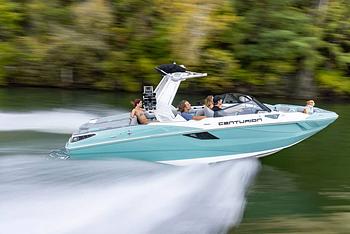
20th Mar 2024
Best Wakesurf Boat Brands
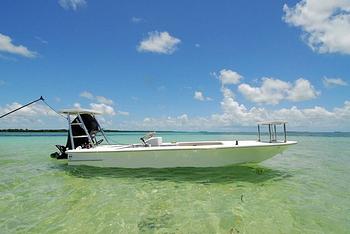
4th Mar 2024
The Best Flats Boats Brands, Special Boats for Skinny Waters
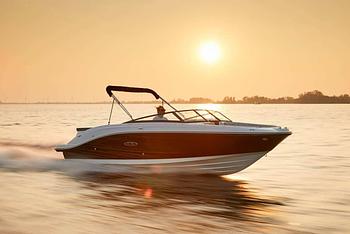
21st Feb 2024
Best Lake Boat Brands for Fishing, Cruising, and Watersports

15th Feb 2024
Best Aluminum Fishing Boat Brands: Tougher, Lighter and More Affordable
- Explore Rightboat
- Boats for Sale
- Boating Articles
- Buyers Guide
- About RightBoat
- Sell Your Boat
- Boat Selling Advice
Enter your email to keep up to date with the latest news
Join for free
Sign up now for free and discover how easy it is to keep up to date with THE latest boats for sale. Find your right boat, and tailor your voyage to finding your next boat.
Benefits of becoming a member:
- Set up tailored alerts
- Personalise your experience
- Download full specifications and broker details
- Keep tabs on your favourite boats
Are you a broker? Join as a Broker
Rightboat - join for free.
Do you have an account already? Login
Save this search
Save your search and receive new boats in your email..
You can unsubscribe from your alerts whenever you like. By pressing the button you accept the Legal Terms and conditions
A Guide to Yacht Water Systems
- by yachtman
- September 10, 2023 August 26, 2023

Welcome to the yacht water systems world! Love the open sea? Then understanding and maintaining your yacht’s water systems is key. This guide will provide useful info for smooth sailing. Let’s explore the parts that make up these intricate systems.
The freshwater tank is vital. It holds drinking, cooking, and shower water. Regularly check and sanitize these tanks to avoid contamination.
Watermakers are also needed. They convert seawater into clean, drinkable water. Having an efficient one guarantees fresh water during long trips.
Yachts have plumbing systems too. Pipes, valves, pumps, and filters all play a role in maintaining proper water flow. Regular maintenance and inspection are necessary to detect any leaks or blockages.
Stay informed to make the most of your yachting experience. We will provide expert advice and tips. Don’t miss out on these insights that will guarantee a seamless, enjoyable voyage.
Understanding Yacht Water Systems
To deepen your knowledge about yacht water systems and their functioning, equip yourself with an understanding of the subject. Gain insights into the types of yacht water systems and the significance of proper maintenance.
Types of Yacht Water Systems
Yacht water systems are essential for onboard comfort and convenience. Different types exist, each with its own features and benefits. To explore these, here is a table:
Additionally, hybrid systems incorporate different technologies or alternative energy sources for improved efficiency and sustainability.
The history of yacht water systems dates back centuries, when manual labor was needed to get and transport freshwater on sailing vessels. As technology advanced, innovations made accessing water more convenient and reliable for yacht owners and crew.
Importance of Proper Water System Maintenance
Maintaining a yacht’s water system is essential. Not doing so can cause contamination and breakdowns. Cleaning, scanning for leaks, and switching out filters are crucial to guarantee a reliable supply of water. Also, monitoring water quality and treating it is vital for safety. Search for professional yacht maintenance services for any difficult issues or setup needs.
Apart from regular upkeep tasks, there are other aspects to think about when it comes to yacht water systems. Guaranteeing sufficient storage capacity is vital, as being overly reliant on shore supplies might not be doable in isolated places. Plus, having redundant systems in place can provide a back-up plan in case of emergency or system failure.
Pro Tip: When doing maintenance on a yacht’s water system, always thoroughly read the manufacturer’s instructions and follow them exactly. This will help avoid any unintended damage or problems that could be costly to fix later.
Components of a Yacht Water System
To understand the components of a yacht water system, delve into the details of water tanks, pumps and filters, and plumbing and distribution system. Each of these sub-sections plays a crucial role in ensuring a smooth and reliable water supply on a yacht. Let’s explore the intricacies of each component to gain a comprehensive understanding of yacht water systems.
Water Tanks
Water tanks are essential on a yacht. They store water securely and provide a steady supply. They come in many materials like stainless steel, plastic, and fiberglass . Tanks can be put in below deck, aft compartments, or forward sections . They often have level indicators and filters to monitor water levels and guarantee quality. Invest in quality water tanks for peace of mind and comfort. Get them now!
Pumps and Filters
A yacht water system uses various pumps and filters. Here’s an overview:
- Fresh Water Pump: Provides water pressure throughout the system. Example: Shurflo Aqua King II .
- Saltwater Pump: Supplies seawater for purposes. Example: Jabsco ParMax Plus .
- Bilge Pump: Removes excess water from the bilge area. Example: RuleMate Automatic .
Filters also help remove impurities and contaminants. Types include:
- Sediment Filters: Trap sediment, debris, or solid particles.
- Carbon Filters: Eliminate chlorine, odors, and tastes.
- Reverse Osmosis Filters: Remove dissolved impurities with advanced membrane technology.
- UV Filters: Ultra-violet light disinfects water, killing bacteria, viruses, and microorganisms.
Pro Tip: Regularly maintain pumps and filters. Check manufacturer guidelines for cleaning or replacing filter cartridges, and inspecting pump seals for wear or leakage.
Plumbing and Distribution System
The plumbing and distribution system is key for a yacht’s water system. It lets water move smoothly throughout the vessel. This includes pipes, valves, pumps, and fittings distributing freshwater and removing wastewater.
Let’s look at a table of components:
Modern systems may also have filtration systems and sensors. These filter out impurities and monitor parameters like pressure and temperature.
Plumbing and distribution systems are vital for having clean freshwater on your yacht. Neglecting this system can cause issues like leaks, reduced efficiency, or complete failure. So, yacht owners should inspect, maintain, and upgrade their plumbing system. This ensures convenience, safety, and comfort. Don’t forget to take care of this essential component! Protect your yacht’s water system by paying attention to its plumbing and distribution system.
Maintaining and Troubleshooting Yacht Water Systems
To maintain and troubleshoot your yacht water systems effectively, follow this guide. Clean and sanitize your system regularly to prevent any issues. Learn how to deal with common problems that may arise. And when needed, consider hiring a professional to assist you.
Regular Cleaning and Sanitization
- Make it a habit to clean the water tanks regularly. This helps keep water onboard safe.
- Sanitize the whole water system from time to time to get rid of bacteria, viruses, and other microorganisms. This is a must for hygiene.
- Don’t forget to clean filters and screens. These stop debris from getting stuck in pipes.
- Inspect and scrub faucets, showerheads, and other water outlets to avoid mineral build-up.
- And when you come back from a trip or if the yacht has been still for a while, flush out the water lines. Stagnant water can cause bacteria.
Remember, cleaning and sanitization is not only good for health, but also for preserving your yacht’s water systems.
Dealing with Common Issues
Boating owners know the annoyance of common water system issues on yachts. It’s vital to take swift action to prevent sailing difficulties. Here are some common problems and how to manage them:
- Leaks: Inspect and fix any pipe or fitting leaks ASAP.
- Clogged Filters: Clean or replace filters for efficient system performance.
- Pump Malfunction: Check the pump regularly to maintain water pressure.
- Foul Odors: Clean and disinfect tanks and pipes to reduce bad smells.
It’s also smart to have spare parts and a dependable technician handy. Taking care of water systems is key to avoiding headaches.
Furthermore, preventive maintenance is essential. Flush tanks, check valves, and scan hoses regularly to diagnose potential issues early.
A cautionary tale shows the importance of dealing with common issues. A group of sailors set off on a voyage and found their freshwater supply was severely reduced due to leaks. With no easy way to fix the issue, they had to ration water severely. This story serves as a reminder of the need to address common issues to avoid troubles at sea.
Hiring Professional Help
- Go for a reliable firm or expert with a good track record in taking care of yacht water systems.
- Check out their qualifications like licenses and certificates to make sure they are fit for the job.
- Get references from previous customers to judge their dependability and quality.
- Chat about your personal needs to be certain they know what to do.
- Find out the total cost, including any extra payments.
- Stay in touch throughout the process to rapidly address any dilemmas.
- Also, enquire if they provide warranties or guarantees for their services. And make absolutely sure you understand their maintenance plan to avert any unexpected surprises later.
Tip: Inspect your yacht’s water systems often and do minor upkeep yourself to prevent bigger difficulties.
Tips for Efficient Water Usage on a Yacht
Efficient water use is paramount in a yacht environment. Limited resources and an isolated lifestyle mean making the most of your supply is vital. Here are tips to help you stay efficient and minimize wastage on your voyage:
- Try installing water-saving fixtures like low-flow faucets and showerheads. These can reduce water use without diminishing comfort.
- Be aware of your daily habits. Simple things like turning off the faucet while brushing teeth or using a dishwasher with a full load can make a real difference.
- Consider implementing a greywater recycling system. This allows you to reuse water from sinks, showers, and laundry for non-drinkable activities like flushing toilets or cleaning decks.
It’s also important to take good care of your yacht’s water systems. Check for leaks, repair any issues straight away, and clean filters often for the best results.
For an unforgettable yachting experience and a greener future, follow these tips for efficient water usage on your voyage. Every single drop counts!
Wrap up of yacht water system guide? Check! Reliability and efficiency is a must for a blissful sailing experience. Maintenance and monitoring are key.
We’ve looked into different systems available, their components, and factors to consider when choosing. Water quality and methods to make sure it’s top-notch also discussed.
Water scarcity not yet covered . Climate change and sustainability are becoming more pressing. Yacht owners must be conscious of usage and adopt conservation practices.
Take advantage of reliable water systems. Invest in regular maintenance and check out new technologies. Now is the time to make sure you can sail worry-free and protect our water resources.
Frequently Asked Questions
FAQ 1: What is a yacht water system?
A: A yacht water system refers to the plumbing and supply system that provides fresh water on a yacht. It includes tanks, pumps, filters, pipes, faucets, and showers.
FAQ 2: How do I fill the water tanks on my yacht?
A: To fill the water tanks, you can connect a shore hose to the dockside water supply or use an onboard watermaker or desalination system to convert seawater into fresh water.
FAQ 3: How often should I sanitize the water tanks?
A: It is recommended to sanitize the water tanks at least once a year. You can do this by using a water tank cleaning solution and following the manufacturer’s instructions.
FAQ 4: How do I prevent water contamination in my yacht’s water system?
A: To prevent water contamination, always ensure the water tanks are clean and properly sealed. Use potable water hoses for filling, regularly replace filters, and avoid using the water system for anything other than drinking and cooking.
FAQ 5: What should I do if there is no water flow from the faucets?
A: If there is no water flow from the faucets, check if the water pump is turned on and if there is a sufficient water supply. Also, inspect the filters and valves to ensure they are not clogged or closed.
FAQ 6: How do I winterize the yacht water system?
A: To winterize the yacht water system, drain all water from the tanks, pumps, and pipes. Use antifreeze to protect the system from freezing, following the manufacturer’s instructions. It is best to seek professional assistance for winterization.
Leave a Reply Cancel reply
Your email address will not be published. Required fields are marked *
Save my name, email, and website in this browser for the next time I comment.
Please use a modern browser to view this website. Some elements might not work as expected when using Internet Explorer.
- Landing Page
- Luxury Yacht Vacation Types
- Corporate Yacht Charter
- Tailor Made Vacations
- Luxury Exploration Vacations
- View All 3567
- Motor Yachts
- Sailing Yachts
- Classic Yachts
- Catamaran Yachts
- Filter By Destination
- More Filters
- Latest Reviews
- Charter Special Offers
- Destination Guides
- Inspiration & Features
- Mediterranean Charter Yachts
- France Charter Yachts
- Italy Charter Yachts
- Croatia Charter Yachts
- Greece Charter Yachts
- Turkey Charter Yachts
- Bahamas Charter Yachts
- Caribbean Charter Yachts
- Australia Charter Yachts
- Thailand Charter Yachts
- Dubai Charter Yachts
- Destination News
- New To Fleet
- Charter Fleet Updates
- Special Offers
- Industry News
- Yacht Shows
- Corporate Charter
- Finding a Yacht Broker
- Charter Preferences
- Questions & Answers
- Add my yacht
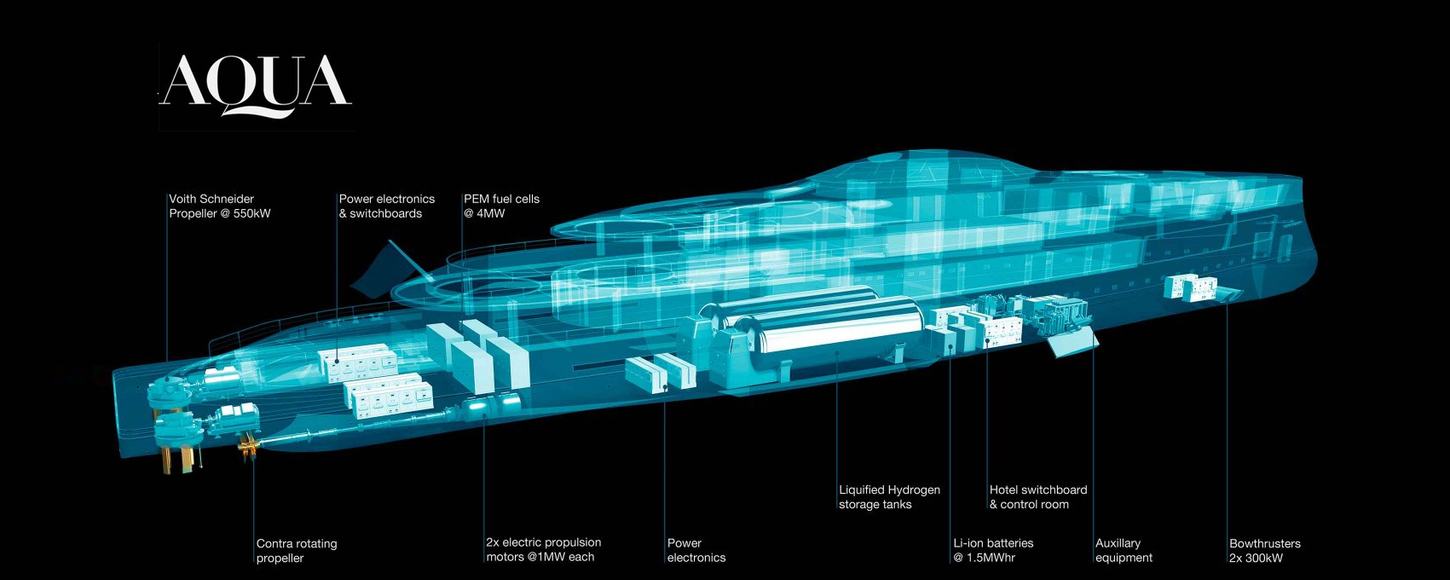
- Yacht Charter Fleet
Inside AQUA: The 112m hydrogen-powered superyacht concept which emits only water
- Share this on Facebook
- Share this on X
- Share via Email
By Katia Damborsky 10 February 2020
Computer-generated images give us a look inside the 112m/ 372ft superyacht AQUA , an eco-friendly concept developed by Sinot Yacht Architecture that is powered by liquid hydrogen and emits only water.
Breaking new ground in form and function, AQUA is a yacht concept that’s at the cutting-edge of what is possible in superyacht design and engineering today.
The yacht concept was presented at the 2019 Monaco Yacht Show by Sinot, the esteemed Dutch design studio. They have collaborated with Lateral Naval Architects for the yacht’s naval architecture.
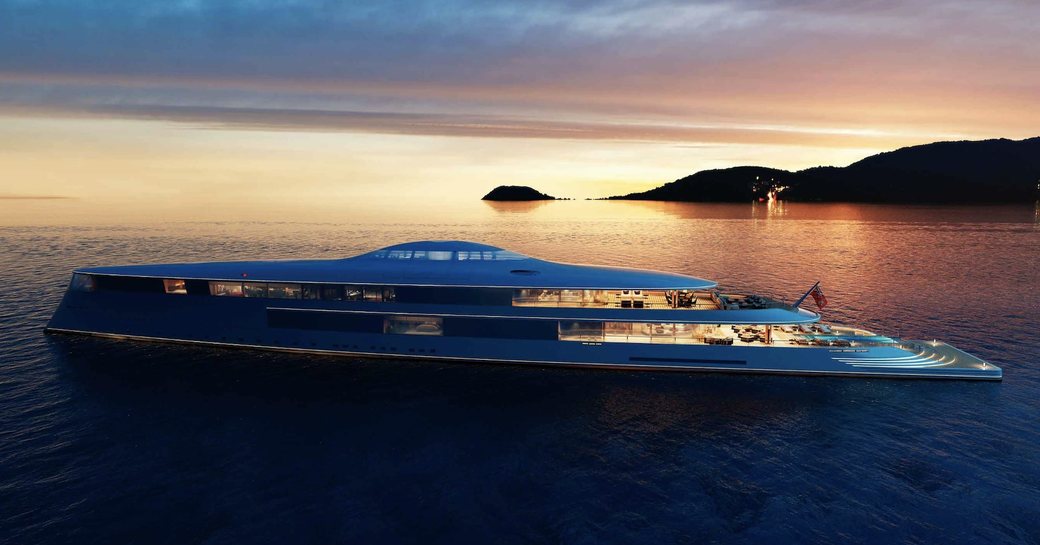
AQUA will be powered by liquid hydrogen stored in two on-board tanks at -423F, meaning the yacht’s only emission is water. This innovative technology nods to her namesake.
She comes with an incredible selection of amenities, including a waterfall pool and fully-equipped spa.
Speaking about the concept, designer Sander Sinot said: “For the development of Aqua we took inspiration from the lifestyle of a discerning, forward-looking owner, the fluid versatility of water and cutting-edge technology to combine this in a 112-metre superyacht with truly innovative features.
“Our challenge was to implement fully operational liquid hydrogen and fuel cells in a true superyacht that is not only groundbreaking in technology, but also in design and aesthetics."
Alfresco areas
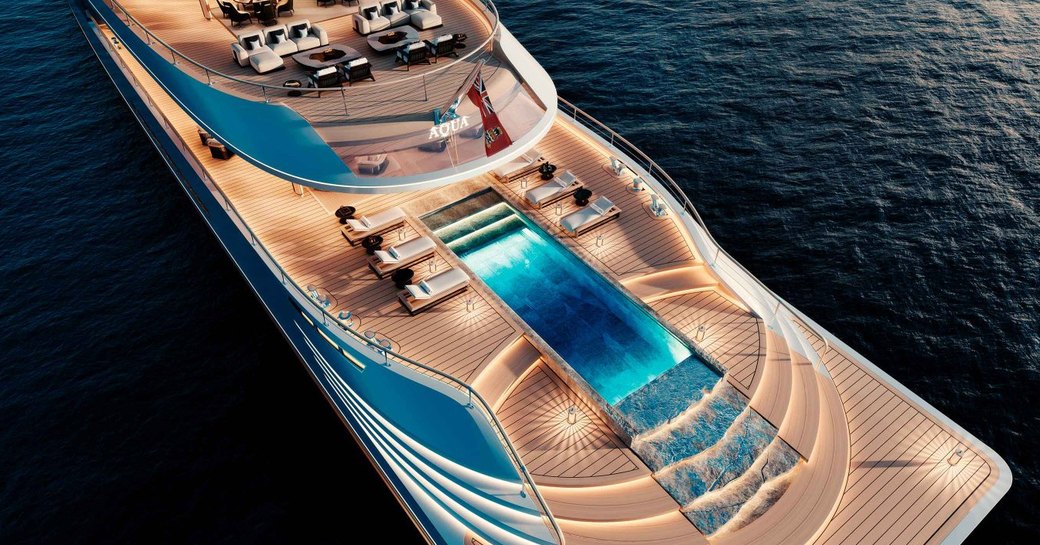
According to Sinot, AQUA has been designed to provide her guests with a constant connection to the ocean.
Renderings show an exterior inspired by the ocean, with sweeping lines and a futuristic profile that looks similar to a spaceship. Large portions of glass and bubble-hood wheelhouse add to the contemporary look.
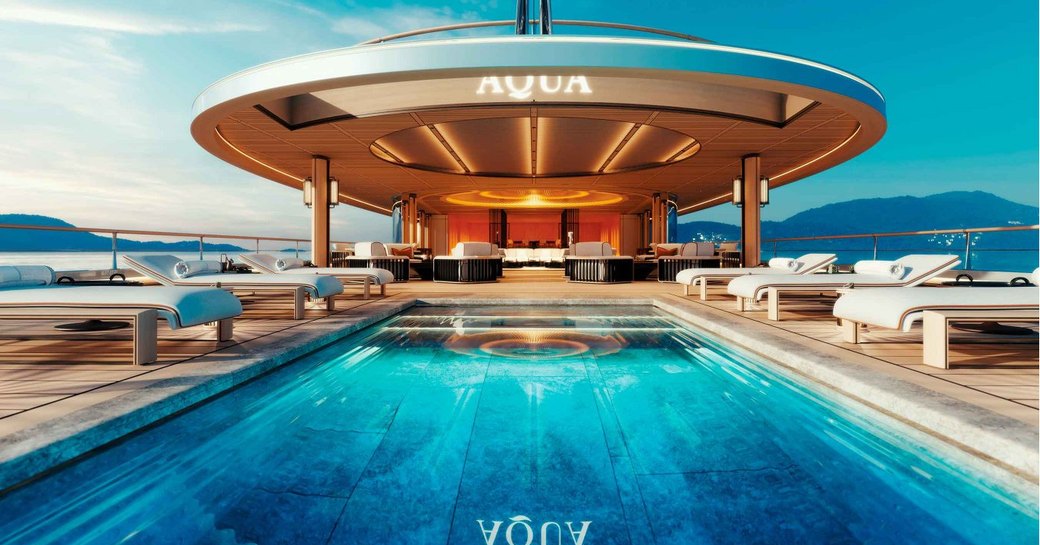
The yacht’s alfresco areas are centred around the aft decks, which have been designed to provide maximum volume and space. The main deck aft is dominated by a huge pool flanked by steps, with a cascading water feature that offers a show-stopping entrance to anyone stepping on board.
A variety of seating options are scattered across the deck, before the space merges seamlessly with the yacht’s main salon via sliding, floor-to-ceiling glass doors. This creates a versatile winter garden that allows the deck to be enjoyed by the entire party.
The circular seating area also allows the space to function as a home cinema.
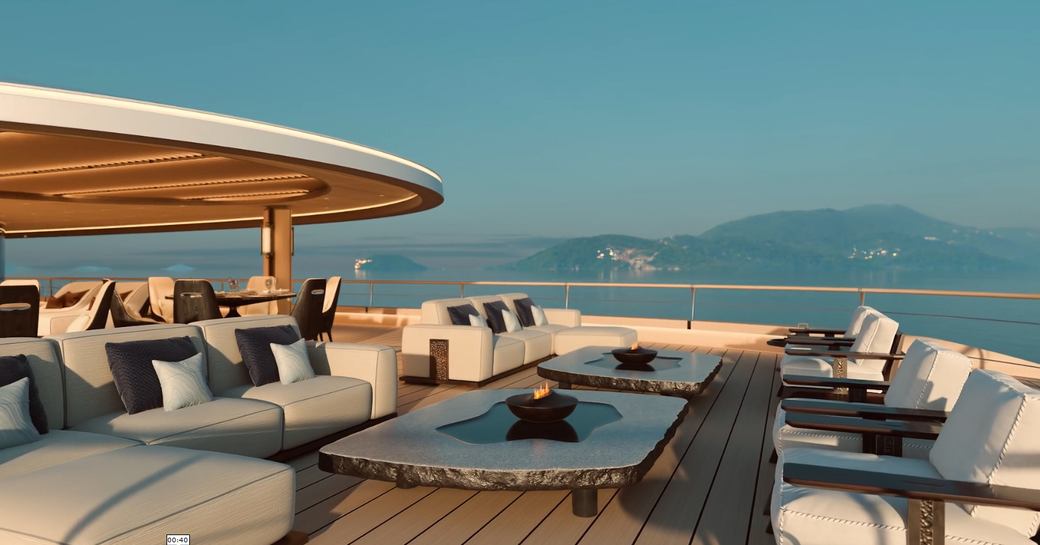
Open space continues on the upper deck aft, where guests will find more seating arranged around fire pits. Formal dining can be found forward, in an open setting that offers panoramic views over the surroundings. This deck can offer privacy or open entertainment space dependent on the needs of the guests, thanks to Japanese shoji grid screens.
Accommodation

Accommodation is provided for a total of 12 guests in seven cabins.
Occupying the forward area of the upper deck, the vast owner’s deck is a vast, interlinked space divided by finely crafted wooden screens that allow for complete privacy. On the starboard and port sides, floor-to-ceiling windows offer incredible views and influxes of light.

The ceiling in the owner’s deck varies between 280cm to 380cm, with the tallest point at the central skylight. A wooden structure extends from the skylight, with a raised platform at the base that creates a stage or display area.
The en suite facilities in the owner’s apartment are one of the focal points on board. High gloss black marble floors complement the incredible panoramic views, with a freestanding geometric tub in the centre.

His and hers vanities, basins and crescent-shaped mirrors flank the space. Large walk-in wardrobes and an office area add a level of convenience.
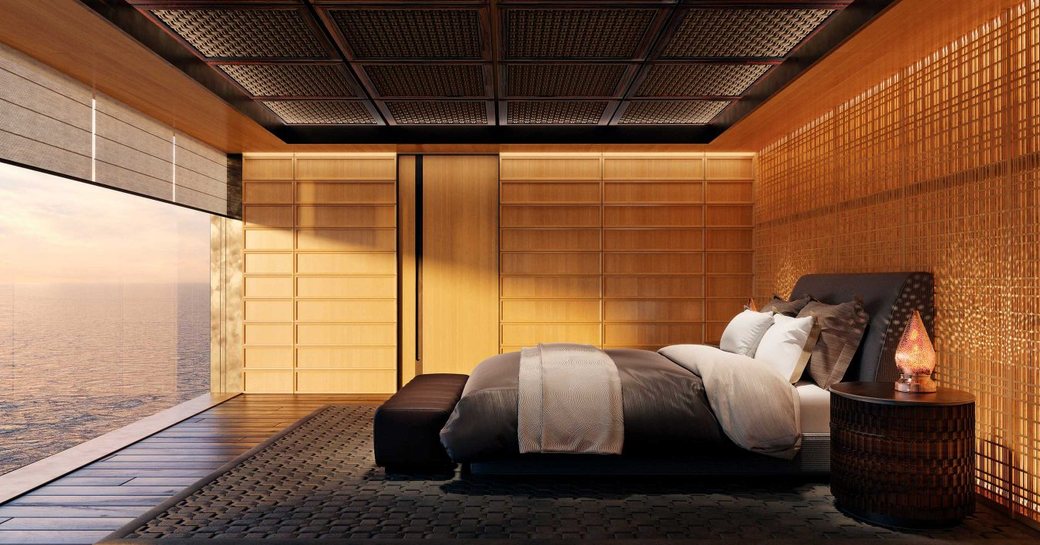
The remaining cabins are similarly styled, with Japanese themes, wide windows and individual en suite bathrooms. Textured silk carpets, wooden furniture and mixed textures on the walls and ceilings contribute to the holistic ambience.
Central Staircase
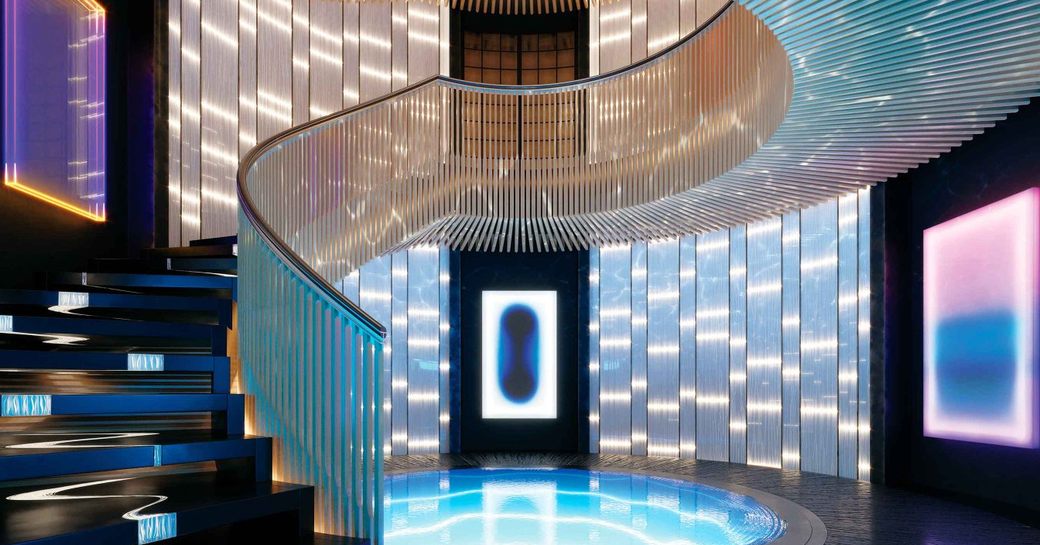
Situated at AQUA’s core, the spectacular circular staircase winds down from the top deck to the lower deck, floating around a cylindrical void.
A skylight is located at the top, and an art piece can be found at the base, which mirrors the skylight and reflects an ocean theme. On the lowest level, a panel of glass allows guests to see the two liquified hydrogen tanks which power the yacht.
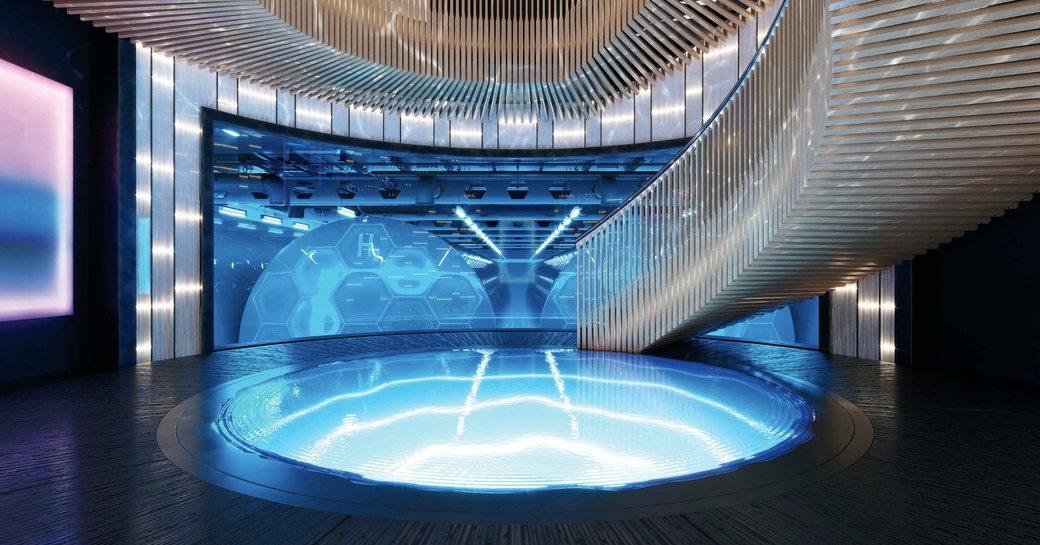
The staircase itself features a finely crafted wooden balustrade that seems to defy gravity and catches the light created by the wave structure of the artwork. Backlit glass inserts in the steps accentuate the motif of flowing water, trickling down from the bridge deck.
Spa and Gym Area
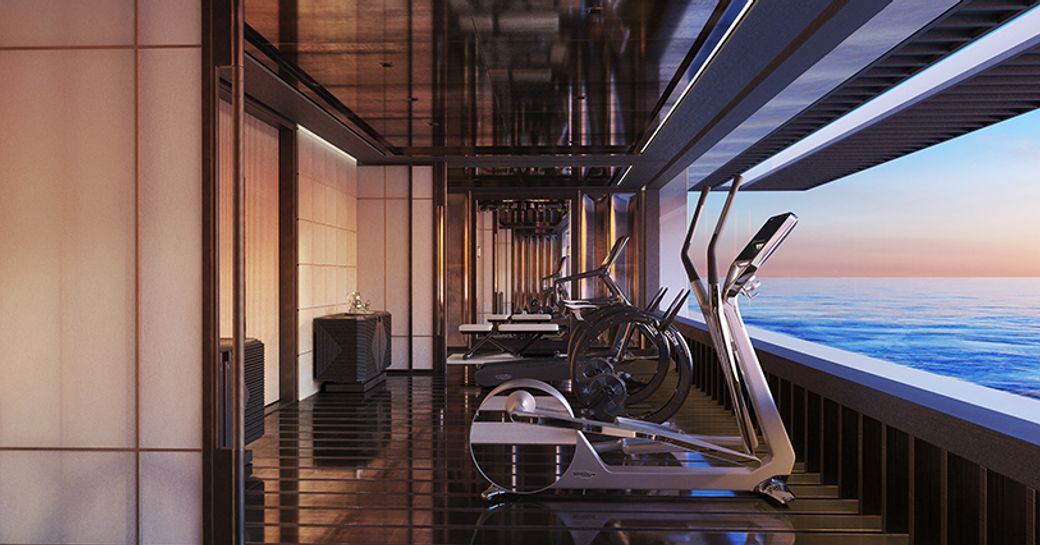
Accessed via a circular tunnel, the health and wellness centre boasts an exclusive hydrotherapy suite and a water-level gym. The gym area opens out, giving guests the feeling of working out while being connected to the water.
There is a yoga space and workout floor, with plenty of the latest exercise equipment to ensure guests can keep up their fitness regimes.
The Aqua Room
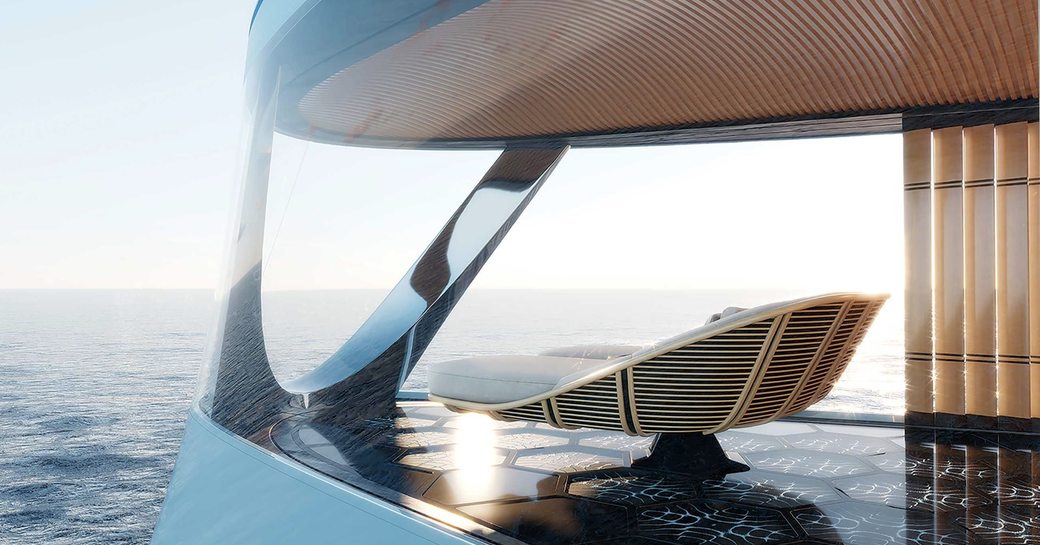
Situated at the very bow of the yacht, the AQUA room adjoins the owner’s apartment and offers an incredible observatory area with some of the best views on board. It can remain the owner’s secret, or be enjoyed by the entire party.
While underway, guests will love getting comfortable and enjoy the feeling of being totally at one with the ocean thanks to full-height windows that eliminate the borders between the outside and the inside. A stainless steel structural support adds a polished finish to the room.
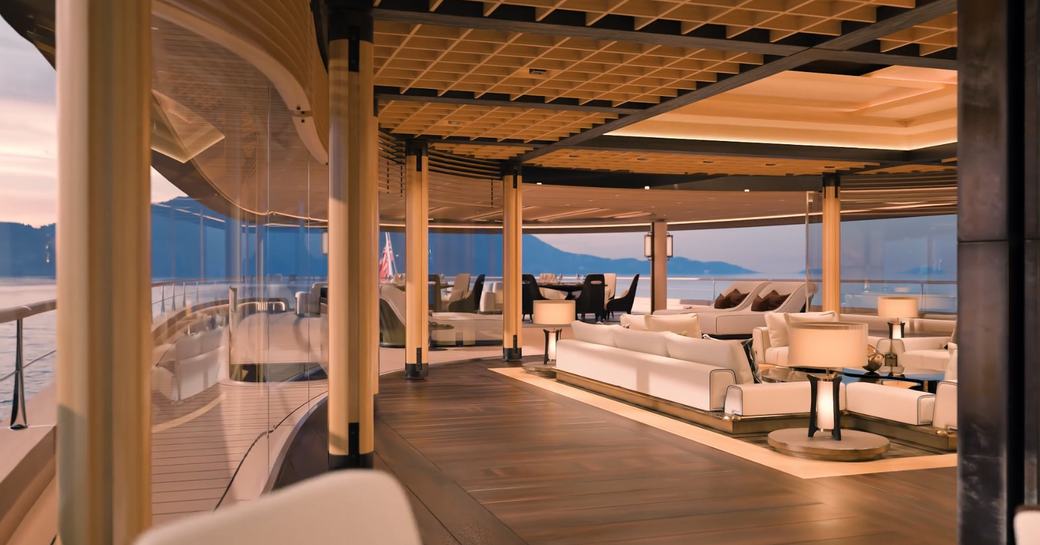
The yacht’s interiors are a fine balance of elegance and understated, with an overarching contemporary theme. There is a large main salon with sumptuous sofa seating, a stone-paneled wall and bronze-finished sculptures.
The skylounge is primed for daytime relaxing, with huge expanses of glass and recessed seating.
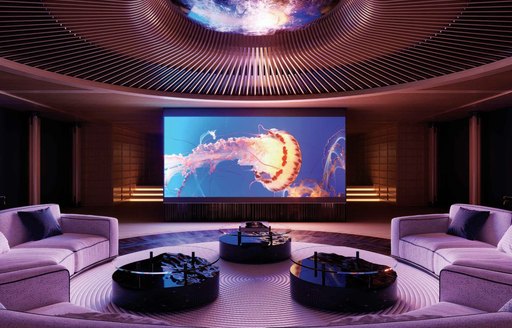
How does the hydrogen technology work?
The hydrogen is pumped through a special type of fuel cell which converts it into electricity while emitting only water which can be safely pumped into the ocean.
Despite its novel fuel source, the vessel is able to reach 17 knots and travel 3,750 miles before it needs to refuel, enough to cover an Atlantic crossing from New York to Southampton.
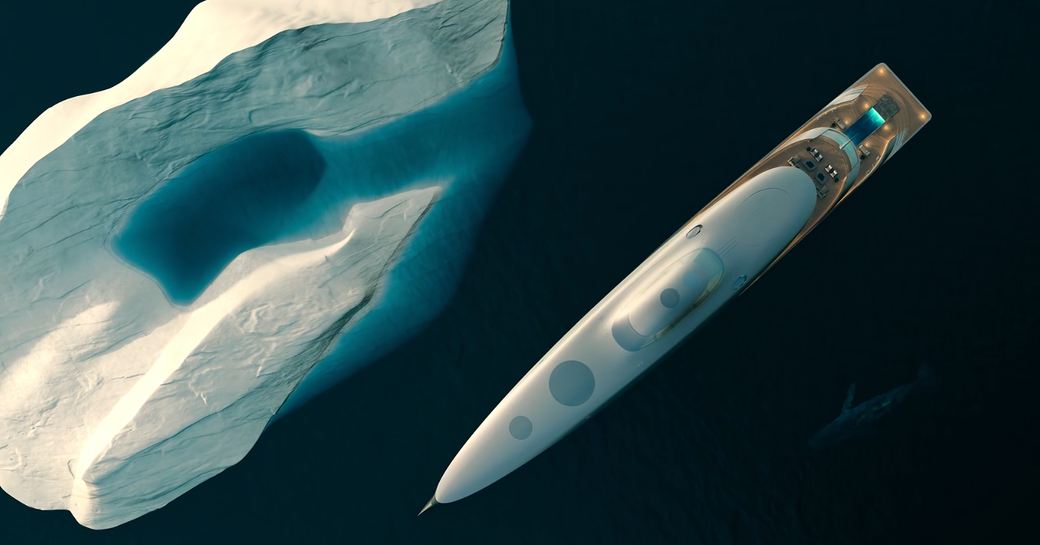
What’s the price of AQUA?
The yacht is reported to cost around $645 million.
Media reports stated the yacht was being built by Feadship and had been purchased by Bill Gates. These claims have been denied by Sinot. The Dutch designers have said that any links between Aqua and Mr. Gates are "factually incorrect."

To learn about chartering an eco-friendly superyacht, please get in touch with your preferred yacht charter broker .
Stand-out superyachts for charter:
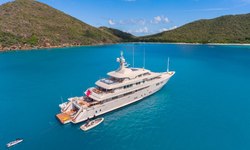
62m Icon Yachts 2013 / 2019

73m Picchiotti 2014
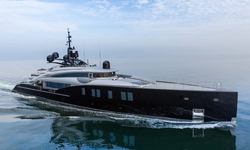
66m ISA 2014 / 2023

84m Feadship 2015 / 2020
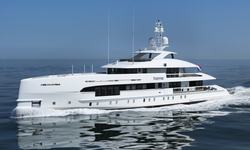
50m Heesen 2017

50m Tankoa Yachts 2017
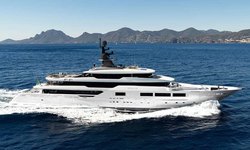
72m Tankoa Yachts 2018 / 2023
RELATED STORIES
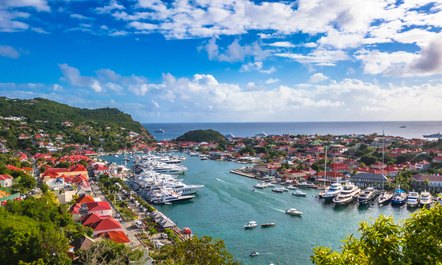
Previous Post
Feadship unveils superyacht Project 1008 as MOONRISE
40m Benetti charter yacht 'Happy Me' hits the water
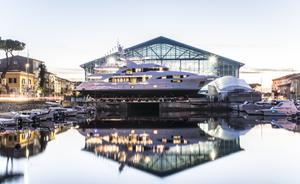
EDITOR'S PICK

Latest News
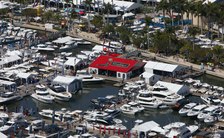
21 March 2024
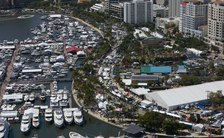
20 March 2024

19 March 2024
- See All News
Yacht Reviews
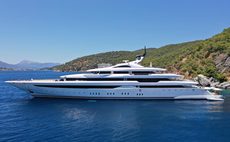
- See All Reviews

Charter Yacht of the week
Join our newsletter
Useful yacht charter news, latest yachts and expert advice, sent out every fortnight.
Please enter a valid e-mail
Thanks for subscribing
Featured Luxury Yachts for Charter
This is a small selection of the global luxury yacht charter fleet, with 3567 motor yachts, sail yachts, explorer yachts and catamarans to choose from including superyachts and megayachts, the world is your oyster. Why search for your ideal yacht charter vacation anywhere else?

136m | Lurssen
from $4,342,000 p/week ♦︎
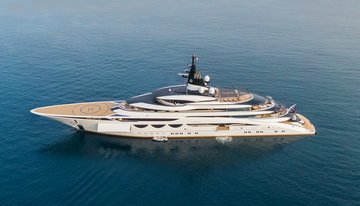
115m | Lurssen
from $2,822,000 p/week ♦︎
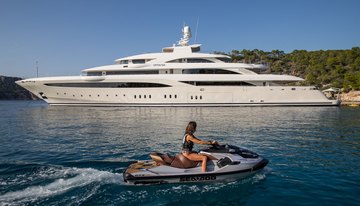
85m | Golden Yachts
from $978,000 p/week ♦︎
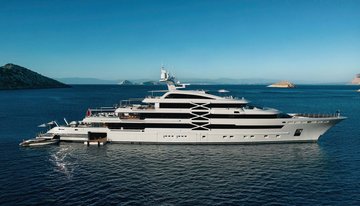
88m | Golden Yachts
from $1,195,000 p/week ♦︎
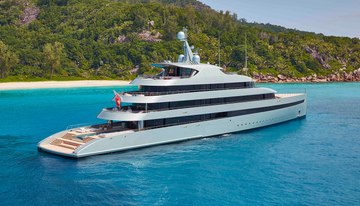
84m | Feadship
from $1,085,000 p/week ♦︎

93m | Feadship
from $1,521,000 p/week ♦︎
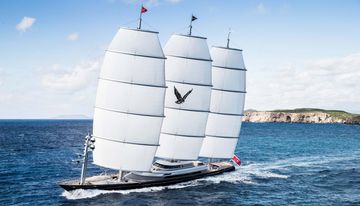
Maltese Falcon
88m | Perini Navi
from $490,000 p/week
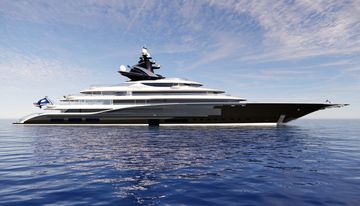
122m | Lurssen
from $3,000,000 p/week
As Featured In
The YachtCharterFleet Difference
YachtCharterFleet makes it easy to find the yacht charter vacation that is right for you. We combine thousands of yacht listings with local destination information, sample itineraries and experiences to deliver the world's most comprehensive yacht charter website.
San Francisco
- Like us on Facebook
- Follow us on Twitter
- Follow us on Instagram
- Find us on LinkedIn
- Add My Yacht
- Affiliates & Partners
Popular Destinations & Events
- St Tropez Yacht Charter
- Monaco Yacht Charter
- St Barts Yacht Charter
- Greece Yacht Charter
- Mykonos Yacht Charter
- Caribbean Yacht Charter
Featured Charter Yachts
- Maltese Falcon Yacht Charter
- Wheels Yacht Charter
- Victorious Yacht Charter
- Andrea Yacht Charter
- Titania Yacht Charter
- Ahpo Yacht Charter
Receive our latest offers, trends and stories direct to your inbox.
Please enter a valid e-mail.
Thanks for subscribing.
Search for Yachts, Destinations, Events, News... everything related to Luxury Yachts for Charter.
Yachts in your shortlist
How Do Cruise Ships Get Fresh Water?

Water is the source of life, and each living person requires a lot of it on a daily basis. With that in mind how do cruise ships get fresh water while out in the vastness of the open sea?
A cruise ship is a complicated vessel that requires the interoperability of multiple systems for it to function properly. That includes making sure that its crew and passengers are well taken care of biologically and hygienically.
As cruise ships grow ever larger and more complex, further people and additional attractions will naturally accompany this growth. That is bound to make freshwater use increase dramatically.
This leads us to the core of this guide on how cruise ships acquire useable freshwater and in large quantities at that.
How Cruise Ships Get Fresh Water
Some cruise ships have near Olympic-sized swimming pool levels of stored water on board. But even that has its limits especially on extended voyages miles away from the nearest source of freshwater.
That said, engineers solved this problem by simply not relying on a single method for its acquisition. Instead they branched out using multiple technologies and systems that allow for increased efficiency in water utilization and even water treatment and recovery systems all onboard the cruise ship itself in order to recycle the water after being used.
Bunkering is a maritime term for supplying logistics to a ship. In this context, bunkering means the carrying of freshwater from a local source in port and loaded onto the ship.
This is the simplest method of getting freshwater. However, this is not a sustainable method because aside from the problem of needing a huge amount of space to fit everyone’s daily water needs plus that of the machinery in radiators for example, and in attractions like a pool, this stockpiled freshwater will run out within a few days, significantly hindering a cruise ship’s range and operational time.
Desalination
As previously mentioned the stored freshwater onboard will run out quite quickly unless there was a way to continuously acquire it during the voyage.
But isn’t a ship surrounded by water and why not use that you say?
Seawater obviously isn’t safe for consumption and use either by people or by machinery. However, you are on the right track in that seawater can be cleaned out and processed into freshwater.
Fortunately, we have a process called desalination, which is the removal of salt and other impurities from water, and there are two standard methods of doing it.
Reverse Osmosis
This is a method in which the source water, seawater, in this case, is pressurized and pushed through a series of membranes only large enough for water molecules to pass through but blocking everything else.
This results in all the salt and impurities getting stuck on these membranes, and leaving only clean fresh water at the end.
The downside to this method is that it requires these membranes to be constantly cleaned to maintain freshwater output which leads to operational downtime, and they do have a limited number of uses before needing to be replaced.
Evaporation
Another method of desalination is something even survivalists use but on a much larger scale. Simply boiling water causes it to evaporate as pure water vapor, with all the salt and dirt left behind, this water vapor is then pumped into condensers which turn it back into liquid water.
Now, this is great since it is constantly operating plus the removal of impurities can be automated without needing to stop the machine’s operation.
Unfortunately, this requires a huge amount of energy which could’ve gone to powering electronics, navigational systems, and attractions, not to mention the resulting condensed water is at near boiling point temperature. Though useful in a hot spa, it is practically useless everywhere else unless additional steps are taken to cool the water before use.
Condensation
Unlike the desalination processes mentioned above which involve actively spending energy and effort in order to clean water, condensation relies on utilizing the potential water sources already present due to normal ship operation.
This isn’t water production per se but rather reducing wastewater by efficiently harvesting other sources of water.
Steam from cooling the ship’s engines, kitchens, and other facilities plus the water produced by air conditioners are all collected and siphoned into a storage tank where they will be cleaned and reused.
Now aeration is also a unique process in that it doesn’t do anything with the water in particular. What it does is that rather than pressurizing the fresh water running through the ship for cooking, cleaning, bathing, and etc, with more water, instead, it uses air.
In order to achieve the same amount of pressure, it mixes in high-pressure air with the water in the pipes so that flushing the toilet, using a shower or faucet, works normally but uses significantly less freshwater.
Although it doesn’t produce more freshwater, it contributes by using less freshwater.
How the Water System Works on a Cruise Ship
It all starts with the bunkering, water is stored on the ship. As this water gets used through various operations, these are then treated and recycled as under every ship lies a water treatment and recycling plant.
Sewage is treated and discarded as waste water, whereas water that comes from other sources like pools and engine operation can be recycled by using the methods mentioned previously.
Seawater is also utilized to help cool some machinery then can be desalinated for further use.
How is Water Saved on a Cruise Ship?
Through the multi-staged processes of aeration and condensation, a sizeable amount of water can be saved. Add desalination processes to that and you can be sure that most of the water stored in the cruise ship will be recycled, reused, and will last until the next port.
How Much Water Do Cruise Ships Carry?
Cruise ships have large internal storage tanks for freshwater, in the magnitude of thousands of gallons at a time, and some can even carry up to two million liters of freshwater and that’s 500,000 gallons worth.
In conclusion, cruise ships are loaded with freshwater while docked, then combinations of onboard desalination systems allow for the production of water. Finally, efficiency systems make sure that water is properly utilized and that is the answer as to how do cruise ships get fresh water.
Related Posts

How Long Does it Take to Get Off a Cruise Ship? *Disembark

What is the Best Side of a Cruise Ship to Be On?
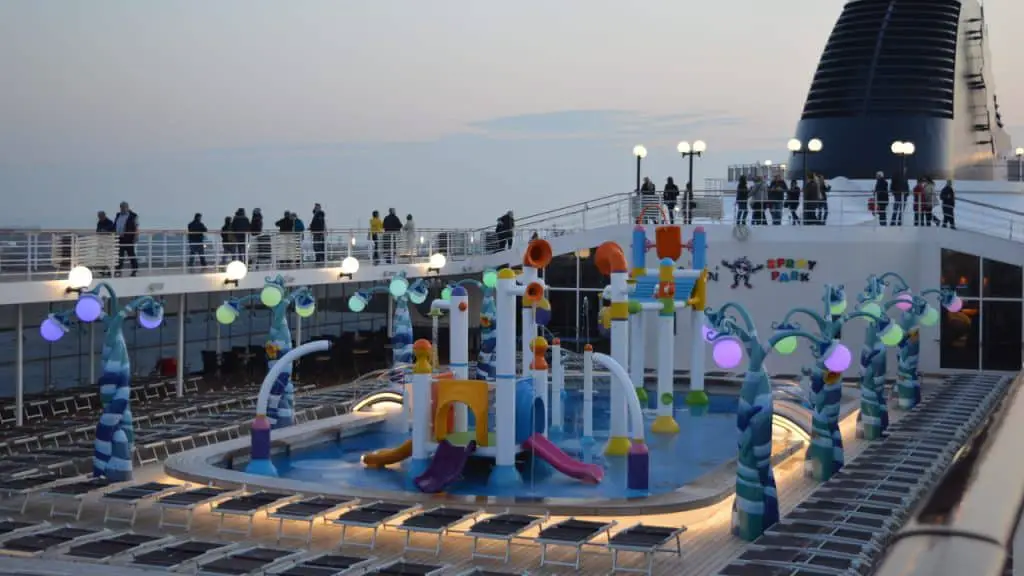
Do Babies Get Seasick on Cruises and Boats?
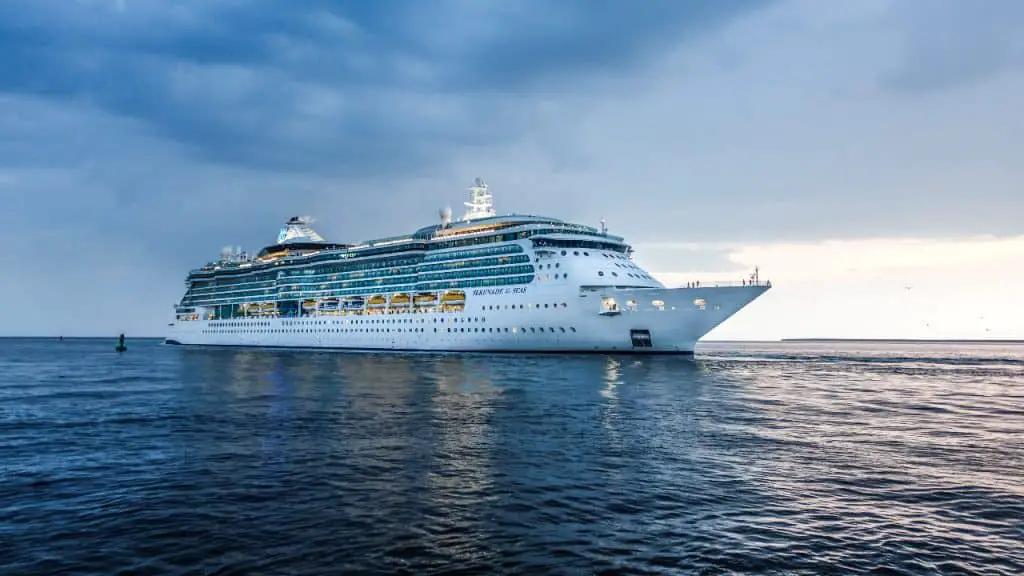
Where to Stay on a Cruise Ship to Avoid Seasickness


The global authority in superyachting
- NEWSLETTERS
- Yachts Home
- The Superyacht Directory
- Yacht Reports
- Brokerage News
- The largest yachts in the world
- The Register
- Yacht Advice
- Yacht Design
- 12m to 24m yachts
- Monaco Yacht Show
- Builder Directory
- Designer Directory
- Interior Design Directory
- Naval Architect Directory
- Yachts for sale home
- Motor yachts
- Sailing yachts
- Explorer yachts
- Classic yachts
- Sale Broker Directory
- Charter Home
- Yachts for Charter
- Charter Destinations
- Charter Broker Directory
- Destinations Home
- Mediterranean
- South Pacific
- Rest of the World
- Boat Life Home
- Owners' Experiences
- Interiors Suppliers
- Owners' Club
- Captains' Club
- BOAT Showcase
- Boat Presents
- Events Home
- World Superyacht Awards
- Superyacht Design Festival
- Design and Innovation Awards
- Young Designer of the Year Award
- Artistry and Craft Awards
- Explorer Yachts Summit
- Ocean Talks
- The Ocean Awards
- BOAT Connect
- Between the bays
- Golf Invitational
- Boat Pro Home
- Pricing Plan
- Superyacht Insight
- Product Features
- Premium Content
- Testimonials
- Global Order Book
- Tenders & Equipment

Where in the world: Top superyacht locations this week
The global superyacht fleet is always on the move. Using BOAT Pro’s pioneering AIS fleet tracker , we keep an eye on the furthest flung superyachts of the week .
Nord in the Seychelles
The 142 metre Nord is undoubtedly one of the most notable launches of the past few years. She became Lürssen's biggest build to date when she hit the water in 2021 and has continued to turn heads with her sheer size, squared-off bow and striking duo-tone hull and superstructure. After a summer well spent cruising in the Mediterranean, Nord made her way to the Maldives in time for Christmas and is now sitting pretty in the Seychelles, anchored off from its capital Victoria.
Lusine in London
At 60 metres in length, the Heesen motor yacht Lusine is the largest steel superyacht to be built by Heesen and was spotted cruising into the mouth of the River Thames on February 14. She is one of a string of new European builds that have arrived in London in the past few months to be delivered. Lusine was built under the name Project Falcon and recently completed intensive sea trials in the North Sea, reaching a top speed of 17.7 knots.
La Datcha in Peru
The 77 metre polar expedition yacht La Datcha has made her way back up the South American coastline after spending the winter season doing what she does best - exploring the frozen fields of Antarctica. Equipped with an ice classed hull and helicopter, La Datcha has been to-ing and fro-ing between Ushuaia and Antarctica over the past few months but is now enjoying the warmer waters of Peru.
Arbema in Cuba
Arbema , previously known as Azteca , came under new ownership in 2021 in one of the biggest sales of the year. The 72 metre CRN superyacht was snapped up after just three months on the market and her new owner has naturally been spending the winter season cruising the Caribbean. She was most recently spotted pulling into Havana, Cuba.
Azamanta in Bermuda
The unmistakable bronze hull of the 55 metre Heesen Azamanta has been spotted pulling into port in Bermuda. She was delivered in 2015 as the first in the Dutch shipyard's 55 Steel series and has been under private ownership ever since. Azamanta 's cruising calendar is often dictated by the seasons - summers in the Mediterranean and winters in the Caribbean - but an ice-reinforced steel hull means she can travel wherever she pleases.
For access to BOAT Pro's pioneering AIS superyacht tracker, visit boatinternational.com/boat-pro .
More stories
Most popular, from our partners, sponsored listings.
The superyacht world is speculating that Mark Zuckerberg just bought this 118-meter boat
- The 118-meter superyacht Launchpad made her maiden voyage last week.
- The yacht world is speculating that her owner is Meta CEO Mark Zuckerberg.
- Here's what we know about the luxury vessel.

In the world of superyachts , privacy is the most valuable asset. It can be next to impossible to discern the details of a superyacht transaction — and that's particularly true if the vessel in question is worth nine figures.
Yet some in the boat blogging world are speculating that Meta CEO Mark Zuckerberg is the new owner of Launchpad, a megayacht currently moored in Fort Lauderdale, Florida after she made her maiden voyage from Gibraltar to St Maarten last week. Launchpad clocks in at 118 meters long, about nine meters shorter than Jeff Bezos' superyacht Koru .
The transaction could not be confirmed, with yacht world insiders declining to share what they know and representatives for Zuckerberg not responding to a request for comment from Business Insider. In the past, reports about Zuckerberg owning superyacht Ulysses have proven false.
Related stories
"It is Feadship's standard policy to never divulge any information about our yachts with reference to ownership, costs, or delivery, etc," Feadship, the ship's builder, wrote to BI. "Whether it is an 18-meter Feadship from the 1960s or a 118-meter Feadship from the 21st century, we do not share private information."
But Zuckerberg's name has been connected to Launchpad for a few months now, beginning in December when reports swirled that he visited Feadship's shipyard in the Netherlands.
Then, earlier in March, yachting bloggers like eSysman SuperYachts and Autoevolution started speculating that he officially snagged the boat, originally built for a sanctioned Russian businessman, at a $300 million price tag. (While that's a seemingly huge amount, it's still less than 0.2% of Zuckerberg's $177 billion net worth.)
Another clue that might point to US ownership is that the yacht bears the flag of the Marshall Islands, a US territory and commonplace for American buyers to register their ships, according to public marine tracking.
If Zuckerberg were to have bought Launchpad, he would join a cohort of superyacht-owning tech billionaires . Along with Bezos, the likes of Oracle cofounder Larry Ellison and Google cofounders Sergey Brin and Larry Page have purchased impressive boats with even more impressive amenities.
SuperYacht Times , an industry publication and intelligence platform, has some of the best images of the yacht. Photos show a swimming pool on her main deck and a large helipad.
While less is known of the interior, a vessel of her size can likely sleep dozens of guests and crew and may have amenities like an expansive gym where Zuckerberg could practice his jiu-jitsu or a spa with a massage area. We suspect there's also space for plenty of toys — which could include his viral hydrofoil foil .
Do you have any details about Launchpad or any other superyachts? Email reporter Madeline Berg at [email protected].
Watch: Walmart heiress' superyacht vandalized by activists in Ibiza
- Main content

IMAGES
COMMENTS
Superyachts are essentially self-contained floating cities. They have everything from gourmet restaurants and swimming pools to movie theaters and spas. All of these amenities require water, and fresh water can be hard to come by in the middle of the ocean.
Superyachts can access freshwater through shore connections while docked, allowing for a direct flow of fresh water from the marina or port's supply. Rainwater collection is a sustainable method for obtaining freshwater on superyachts, with collected rainwater going through filtration and storage in dedicated tanks.
The process involves forcing salt water through a membrane that removes the salt, leaving behind clean, fresh drinking water. This water can then be used for drinking, cooking, and other activities. Desalination systems are becoming increasingly popular on superyachts, as they allow yacht owners to travel further and stay longer without having ...
The pipe or hose from the accumulator then feeds to a manifold to supply cold water directly to the toilets, showers, tubs, lavatories, galley sinks and ice makers. It also feeds to a water heater, fitted with a temperature/ pressure relief valve for safety, to supply hot water to the showers, tubs and sinks.
June 09, 2020 An introduction to watermakers for yachts Offered By Astilleros de Mallorca Article by: Yachting Pages With thanks to VDM - Reya , Astilleros de Mallorca and Sea Recovery While water management systems are vital to the smooth and cost-effective running of superyachts, they must operate seamlessly, effectively and without hassle.
Companies in Australia and Germany are also launching new glass-centric freshwater designs. Status's 60-foot, tri-deck Mischief, while boxier and less maneuverable than Invictus, has a sprawling,...
June 24, 2021 How to stow, conserve or generate drinking water for sailing is key for any offshore sailor. Toby Hodges surveyed the 81 skippers of the ARC 2020 fleet for tips TAGS: ARC Gear Top...
In emergencies, superyachts have resources to aid local populations and often act as first responders on scene. Their equipment and speed make them ideal platforms for disaster relief. Over the years, numerous superyacht captains have volunteered the use of their onboard watermakers to supply fresh water to communities in chaos.
To spend extended periods afloat, sailors need large water tanks, cratefuls of bottled water on board, or a watermaker - or preferably all three. So how do you decide how much water to ship...
The company's production is very wide-ranging: Osmosea produces not only watermakers but also complete systems for converting and purifying fresh water into drinking water, which can be drunk directly from tanks, almost completely eliminating the use of plastic on board. This small system, which can be installed on any type of boat, generally comes with the purchase of the traditional or ...
We've done the research and compiled a list of the top 5 luxury yachts in the world - Feadship, Lurssen, Oceanco, Benetti, and Christensen - that offer the ultimate in comfort, style, and performance. Sit back, relax, and let us help you find the perfect luxury yacht for your next sail. The Best Luxury Yachts
Yachts typically get fresh water by way of a hose connected to a dock. This is often done when the yacht is in a marina. Some yachts may also have a freshwater tank that can be filled manually which would require a water source such as a hose connected to a dock, a fresh water lake, a river, or a freshwater stream.
Fresh water, however, can be bunkered or produced from seawater by using a desalination plant on board - the latter saving storage space and cutting a vessel's weight, fuel consumption and CO 2 emissions. For obvious reasons, though, drinkable, or 'potable', water on ships is subject to scrutiny.
Apr 19, 2023 Do Superyachts Have Desalination? For those who love luxury and the open sea, owning a superyacht is the ultimate dream. These floating palaces come with all the bells and whistles of a five-star hotel, including the ability to generate fresh water through desalination. But do all superyachts have this capability? Let's find out.
Yachts typically have fresh water on board through a combination of storage tanks, watermakers, and shore connections. Freshwater storage tanks are built into the yacht's structure and can hold a certain capacity of water. One of the ways that yachts get access to fresh water is by filling up water tanks when the boat is docked.
A yacht's water tanks can be a lively breeding ground for undesirable bugs, especially in warm climates, however, a sub-micron filter will render the water safe to drink. Fresh water systems rarely get a great deal of attention, and yet all crews depend on them for their very survival. However, winterising the system at the…
The average sale price for a superyacht is around €8 million, however a 24 metre yacht could be around €1 million (or less for used superyachts), €11 million in the 40m-50m category, €24 million in the 50m-70m category and around €80 million for yachts of 70m or more.
September 10, 2023 Welcome to the yacht water systems world! Love the open sea? Then understanding and maintaining your yacht's water systems is key. This guide will provide useful info for smooth sailing. Let's explore the parts that make up these intricate systems. The freshwater tank is vital. It holds drinking, cooking, and shower water.
Given the limited availability of freshwater sources at sea, yachts often rely on onboard watermakers or desalination systems to convert seawater into freshwater, ensuring a sufficient and...
By Katia Damborsky 10 February 2020. Computer-generated images give us a look inside the 112m/ 372ft superyacht AQUA, an eco-friendly concept developed by Sinot Yacht Architecture that is powered by liquid hydrogen and emits only water. Breaking new ground in form and function, AQUA is a yacht concept that's at the cutting-edge of what is ...
How do we get fresh water on a sailboat in remote areas and when we're on long passages out to sea? There are actually a few different ways, some easier and...
Simply boiling water causes it to evaporate as pure water vapor, with all the salt and dirt left behind, this water vapor is then pumped into condensers which turn it back into liquid water. Now, this is great since it is constantly operating plus the removal of impurities can be automated without needing to stop the machine's operation.
Builder: Perini Navi Length: 88m Fresh out of a full-scale refit, Maltese Falcon is undoubtedly one of the most unique and technologically innovative sailing superyachts in the world - kitted out with radical unstayed masts made of "weapons-grade" carbon fibre, a FalconRig and computerised sail and mast control system. Be sure to look out for the yacht's eponymous emblem on its middle sail ...
The global superyacht fleet is always on the move. Using BOAT Pro's pioneering AIS fleet tracker, we keep an eye on the furthest flung superyachts of the week.. Nord in the Seychelles. The 142 metre Nord is undoubtedly one of the most notable launches of the past few years. She became Lürssen's biggest build to date when she hit the water in 2021 and has continued to turn heads with her ...
Ruben Griffioen/SuperYacht Times SuperYacht Times , an industry publication and intelligence platform, has some of the best images of the yacht. Photos show a swimming pool on her main deck and a ...